

7 Mental Strategies to Help you Recover from a Presentation Disaster
by Olivia Mitchell | 24 comments

The complaints started within the first half hour of the course:
“I don’t understand what this means”.
“This is too hard for us”.
“This doesn’t work for the presentations that I have to do.”
By the end of the day I was exhausted and dispirited.
At some point in your presenting career something similar may happen to you – your content simply doesn’t land for your audience, your technology breaks down or you don’t get the result you were hoping for.
Here are seven mental strategies to help you recover from a presentation disaster. You’re likely to resonate with some and not others. Choose what works for you.
1. Allow yourself some time to dwell on the disappointment
We live in a society that encourages us to “think positive” all the time. But uncomfortable emotions are a normal part of life. Accepting the disappointment will allow you to let it go more easily and move on. If in the past you’ve stewed about failure in a way that disrupts your life, then give yourself a time limit to experience the disappointment and then use the mental strategies below to help you move on.
2. Practice Self-compassion
We often talk to ourselves in very harsh ways. For example:
“Oh, you’re such a loser. You should have known that somebody was going to ask that question and you should have researched the answer. You came across like a total pillock.”
Can you imagine talking to your best friend like that. No. you’d be more likely to say to them:
“That was a very tricky question that audience member asked. You couldn’t have predicted that. And you did your best to answer it.”
Talk to yourself like you would talk to your best friend.
3. It doesn’t mean anything about you
It’s easy when it comes to a disastrous presentation to conclude that you are the disaster, that you’re incompetent and unworthy.
But this is not the case.
My husband Tony used to do some amateur acting and so had the experience of repeating the same play with the exact same script several days in a row. Some nights the audience expressed their enjoyment and appreciation loudly, some nights nothing. Exact same script, exact same performance. Different audience.
Coming back to your presentation, it could simply be the audience. But even if it was your content that was wrong, or your technology that broke down, your presentation disaster doesn’t mean anything about you as a person.
4. Put it into perspective
There are two ways of doing this:
- Imagine yourself 10 years from now. How will you feel then about this presentation? Will you even remember it?
- How disastrous is this presentation compared to other things in your life that have gone wrong or could go wrong? Your health or the health of a loved one? A breakdown of a relationship? Most disastrous presentations are not that bad.
5. Look for the silver lining
Whenever something goes wrong with a presentation, it’s an opportunity to work out why it went wrong, and to improve how you do things next time you present. For example, with my experience with the confused course participants I could look for how to make the material clearer and how to pre-empt participant concerns before they happened.
6. Who knows whether it’s good or bad
Humans are great at making meaning. As soon as an event happens, we’ll evaluate it and slap a label on it – good or bad.
You may have come across the classic story from the Chinese Taoist tradition about a farmer and his horse:
One day his horse runs away. And his neighbor comes over and says, to commiserate, “I’m so sorry about your horse.” And the farmer says “Who Knows What’s Good or Bad?” The neighbor is confused because this is clearly terrible. The horse is the most valuable thing he owns. But the horse comes back the next day and he brings with him 12 feral horses. The neighbor comes back over to celebrate, “Congratulations on your great fortune!” And the farmer replies again: “Who Knows What’s Good or Bad?” And the next day the farmer’s son is taming one of the wild horses and he’s thrown and breaks his leg. The neighbor comes back over, “I’m so sorry about your son.” The farmer repeats: “Who Knows What’s Good or Bad?” Sure enough, the next day the army comes through their village and is conscripting able-bodied young men to go and fight in war, but the son is spared because of his broken leg.
This story can go on forever, alternating between events which seem good, and those that seem bad.
In this spirit, you don’t know whether this disastrous presentation is good or bad. In fact…
7. Devastating failure often sets the stage for later success

“What’s failure in your life that has set the stage for a later success?”
The answers to this question are mind blowing. Some of these people suffered devastating professional failures which contributed directly to stunning achievements.
Use these strategies next time you have a disappointing experience with a presentation. And let me know what strategies you’ve found useful to recover from a presentation disaster.
Free Course
How to tame your fear of public speaking.
In this video-training series (plus workbook with transcripts) you’ll learn:
- The three things you must know BEFORE you begin to tackle your fear of public speaking
- Why the positive-negative thought classification doesn’t work for fear of public speaking
- The two powerful self-talk tweaks that can make an immediate difference.
You have Successfully Subscribed!
I ask for your email address to deliver the course to you and so that I can keep on supporting and encouraging you with tips, ideas and inspiration. I will also let you know when my group program is open for enrolment. I will keep your email safe and you can unsubscribe at any time.
24 Comments
Great tips, Olivia. I really like the ones about self-compassion and perspective. So true. (And I’d not heard the horse story before – that’s a good way of looking at life!)
Thank you Craig
The story of man and horse not only suitable for presentation disaster but also it gives us a life lesson.Thank you Olivia for the support.
Absolutely Jeena, and most of the strategies in my post can be applied to our life challenges as well.
Please unsubscribe me. There is a legal obligation to provide this option- don’t see a link fir unsubscribe. Thanks
Clear link at bottom of email…?
Hi Finola, I have unsubscribed you. My emails are sent through a professional email provider that provides an unsubscribe link at the bottom of every email, so not sure what happened there. Olivia
Russian greatest poet Alexander Pushkin wrote poetry about 200 years ago. Here are original and translated versions: ?, ??????? ??? ???????? ?????? ??????? ??????????? ??? ? ???? – ??? ?????? ???????, ? ????? – ?????????? ????, ? ?????? – ???-????????????…
How many blissful revelations The spirit of enlightment hides! And then experience born of lapses And genius antinomy-wise And chance, the heavenly inventor…
Thank you Marcel, that is quite beautiful.
Awesome tips. I feel much better. Thank you!
It seems Russian language too difficult for this site even to dispaly))
Will Smith posted motivational speech recently about role of a failure in our life https://www.youtube.com/watch?v=wFf6rhcYkXw
Great message in that video.
Olivia thank you so much for boosting my courage on public speaking, I’m doing better now.
Yay Emmy! That’s great to hear. So pleased for you :-).
wow, thanks so much. I can’t wait to try again
“Who Knows What’s Good or Bad?”.This did it for me, was feeling awful about my presentation. Thank you.
Hi Olivia. Hope you have a good day. I really appreciate this writing. I am undergraduate students and just now my groupmate presentation get a lot of critics from my lecturer thus, as a leader I feel sad to see them with their slides being ignored just like that. I totally blame myself because I was the one who divided what parts they should do and what they should write because they said they just will go with my planned. Although, they didn’t blame me and apologize for their mistakes in the writing and slides, I still feel it was my fault. It is not easy to cope with this feeling but somehow your writing help me to go through it. Thank you so much.
This was very helpful! I feel much better. Thanks.
My husband left me heartbroken for 6 months. After i came in contact with R.buckler11 @ gmail [.] com, my Husband came back quickly. Keep up the good work …………
I think it’s important for kids to learn how to deal with and understand their emotions from an early age since doing so will help them avoid many difficult situations in the future. Healthy relationships are the cornerstone of positive well-being, which is why I have singled out for myself a relationship counselors online https://ca.calmerry.com/relationship-counseling/ where you can find relationship counselors online. Any relationship issues that are lowering one’s quality of life can be resolved with the help of relationship therapy or counseling.
What physical or emotional symptoms of stress do you notice in yourself, and how do you try to manage them to keep yourself healthy?
Thank you for sharing these invaluable strategies for navigating presentation mishaps. It’s comforting to know there are ways to bounce back from challenging moments during public speaking. Allowing ourselves to acknowledge and process disappointment is crucial, as you rightly pointed out. Sometimes, we’re urged to embrace positivity constantly, but acknowledging and experiencing those uncomfortable emotions is a natural wellness center part of our journey. Setting a limit on dwelling allows for a healthier transition to moving forward.
In an effort to maintain one’s health, which physical or emotional manifestations of stress do you personally observe and how do you attempt to regulate them?
Unfortunately, mental disorders in young people are not at all uncommon. However, the cannabis industry now has a variety of products, such as CBD, for treating mental disorders. I’m not young anymore and to relieve stress I use these https://westcoastbud.io/ cannabis concentrates in small doses and it gives excellent results. I advise you to pay attention to this site.
Got an important presentation coming up?
Got an important presentation coming up and: You have so much content that you can't figure out what to leave out? Don't know where to begin your design process? Worried that your material won't be of value? Feeling overwhelmed and can't get started? Can't figure out your theme? Concerned you won't be engaging? Time is running out?

Recent posts
- Why striving to be authentic can be a trap
- The first time is never the best
- The Need to be Knowledgeable
- Would you wear clothes that clash?
- An unconventional approach to overcoming the fear of public speaking
Connect With Me

Recommended Books
Click here to see my favorite presentation books.
I earn a small commission when you buy a book from this page. Thank you!
- Audience (22)
- Content (62)
- Delivery (31)
- Nervousness (30)
- Powerpoint (37)
- Presentation blogs (2)
- Presentation books (4)
- Presentation critiques (9)
- Presentation myths (6)
- Presentation philosophy (5)
- Presentation research (11)
- Presentation skills (23)
- Presenting with Twitter (10)
- Visual thinking (3)
How to Tame your Fear of Public Speaking
- Do you have to perform perfectly?
- Do you beat yourself up if you don't?
- Would you talk to a friend the way you talk to yourself?
- Does it make sense that if you changed the way you talked to yourself, you could reduce your fear of public speaking?
I will show you exactly how in this free video training series and workbook.
Discover more from Speaking about Presenting
Subscribe now to keep reading and get access to the full archive.
Type your email…
Continue reading

What’s Your Unconventional Roadmap to Audience Growth?
Pinpoint the #1 Way to Build an Audience of Future Buyers
Find Out Now!
Make Marketing Suck Less
What to do if your presentation sucked.
By Michelle Mazur > July 31, 2013
Filed Under Coaching/Feedback , Communication , Presentations , Public Speaking

Let's face it – you can't hit every presentation out of the ballpark. What do you do if your presentation sucked?
I don't mean in your mind sucked. I mean it unquestionably without a doubt, and you've got the feedback forms to prove it SUCKED.
How do you recover from a bad presentation?
Table of Contents
- 1 Stop beating yourself up
- 2 Realize Your Message Matters Most
- 3 Presentation autopsy
- 4 Bad Presentations Happen To Good People
Stop beating yourself up
A bad presentation traumatizes. My clients tell me stories of bad speaking experiences that happened 1 year, 5 years or even 10 years ago.
From that time, they started avoiding presentations like Adam Sandler movies (which historically traumatize moviegoers everywhere). That's far too long to be hanging on to a bad experience.
Speaking is like falling off a bicycle – you've got to get right back on. When you've screwed up a presentation, it does no good to ruminate about how much you suck.
Get back on that bike and start figuring out how you can rock it out next time.
When you are asked to speak, say a resounding, “YES!” instead of slinking off resolved never to speak again. If Adam Sandler can keep making craptastic movies, surely you can give another speech.
Realize Your Message Matters Most
The vast majority of the time a presentation flops not because of your delivery but because of your message.
While it's easy to say “I'm just not a good speaker,” realize that a mediocre speaker with an amazing message can still make an impact.
As I've been pivoting my business more and more to work with coaches, consultants, and service-based business owners on the way their business communicates, they realize that their message does so much for their business.
Having one core message (or as I like to call it a 3 Word Rebellion) is key for the success of a business or for the success of your presentation.
Ask yourself was the message clear? Did it focus on one core message?
Message clarity = presentation success.
Presentation autopsy
Grim, dark, and time for a bit of brutal honesty. The upside of giving a presentation that sucked is – it's a great learning opportunity.
Now ask yourself, “Did I do everything in my power to prepare for this presentation”? Did the words, “I can totally wing this,” ever fall from your lips? Here are several digging in the dirt questions to ask yourself:
* Did I really understand my audience? Did I know what they believed about my topic? Did I meet their expectations? Did I answer these three questions about the audience ?
* Did I know my stuff?
* Did I practice my presentation? If you need help with practicing, download my guide to practicing your presentation – TODAY – I mean right now – immediately!
* Did you know how you were going to close the presentation?
* Was I prepared for the audience's questions?
* How was my delivery? Polished or rough or somewhere in between?
Be honest. Giving yourself feedback can show you how you can improve your next presentation to ensure success.
Bad Presentations Happen To Good People
Realize that bad presentations do happen to good speakers and amazing people.
Sometimes you can do all your homework, be clear on your message, practice, know your material backward and forwards and the presentation just misses the mark.
Once I was invited to give a presentation on cultural trends. I worked closely with the meeting planner. In fact, she approved every slide I was going to present. This was an executive-level audience and she wanted the content to be perfect. I researched, I prepped, I practiced, I had great examples.
Five minutes into my presentation, one executive raised his hand and asked “Are these trends based on quantitative research?” My reply was, “No, they are qualitative cultural trends.” He and half the room tuned out. The presentation flopped. My mistake was basing my whole speech on information from one person. That question killed me and there was no way to save the presentation at the moment.
Looking back, I now see that I could have reached out to some of the executives as part of my preparation instead of leaning on the meeting planner. Great lesson. Now it's time to move on.
I recovered. You can too when your presentation sucks. The most important point is: Keep Speaking. Learn from your mistakes and don't let them hold you back.
Create Your One-of-a-Kind Message
Your 3 Word Rebellion is the Key to Growing Your Business & Impact
Yes! I’m ready to rebel!
26 responses to “What To Do If Your Presentation Sucked”
Michelle, as I’ve said before, your articles are very informative and helpful. Your website is a great pool of resourses that I always refer to. Thank you for the great tips, entertainment and content!
Thank you, John! I really appreciate you saying so! By the way, we all really miss you in Seattle.
Michelle, Your article is so helpful! I gave a presentation 4 weeks ago and it was my first presenting experience! I was anxious, my voice was breaking and In the questions part my brain went dead and I couldn’t even think of the questions!. The audience was understanding and did not show a negative reaction to my performance. Now i lookat it and I realize that I should have controlled my anxiety and calmed down. I am still beating up myself even though it has been 4 weeks since the presentation, but I definitely will be presenting again the next opportunity I’ll have. Thank you for your article
You’re welcome! I’m one of those who beats myself up too for things that don’t live up to my personal standard. I feel your pain. Letting go is so hard, but when you think about what you learned – it helps to get back on the presentation bicycle.
Wonderful article, Michelle! The whole premise of our product is founded precisely on what you hit upon here. Performing an autopsy on your presentation is so important, and we feel asking your audience is simply the purest and most honest way to truly discover what was lacking. As you said, best thing to do is to “keep speaking”.
We’d love your opinion/feedback on our new product (PheedLoop). http://www.pheedloop.com
The only way to improve as a speaker is to get feedback. I think it’s also worth noting that not all feedback is created equally. The key is to be open to feedback, apply it, and if it doesn’t work for you don’t be afraid to discard it.
Hey Michelle. What is your advice on having an open Twitter chart going on while you present. I just did a presentation this week and at the request of the social media savvy audience, I opened a chat room but mistakenly tried to moderate a panel while also moderating the Twitter chat. It was not possible to do both and impacted my moderating the panel. The audience made 2-3 comments about my “not moderating”. So I learned and won’t do that again. But I feel awful. Like it was public humiliation. I presented on a telecon yesterday and I normally am NOT nervous via the phone. I had totally anxiety and almost couldn’t breathe. Is there such a thing as speaker PTSD? I got back on the bike but if I was with a live audience they absolutely would have seen my nervousness. Am considering a Xanax prescription. : )
I’d say that you can never serve two masters. Twitter chats move so fast! There’s no way you can engage your audience (who needs to be your priority) and run the chat. The best thing to do is to use the hashtag for the event and after the fact respond to what was tweeted.
It does sound like you have a bit of Speakers PTSD. First, give yourself credit that you tried something different. You experimented. It didn’t work out and you learned for it. Second, forgive yourself for making a mistake. The audience members probably have forgot by now. Finally, the next time you present and you have anxiety about it because you’re afraid your going to fail. Breathe, say to yourself “this situation is different. I’ve got this.”
We all make mistakes. It’s time to forgive yourself.
I gave a presentation this week. I felt myself literally choking on my words, the ticking seconds feeling like hours passing by. Somehow I got A message across and was able to answer questions to the audience out in the main hallway. When I went back to the hotel and slept that night I felt pretty beat down and drained only to awaken in the middle of the night feeling that I hadn’t presented THE message to the audience.
I know that presentation is over and done with and I’ve forgiven the “self” that was on the stage for what he did and didn’t do. Now how do I give those audience members the message that they deserved to hear?
Hi Carlos – that’s a tough question. Unforutnately, you cannot give them the message they deserved to hear. The time has past.
The only thing you can do is learn from the situation. How did you prepare for the presentation? How did your practice? Were you crystal clear on your message and confident on how it was organized? How did you prepare yourself emotionally and physically the morning of the speech and before you stepped on stage? Go beyond forgiving yourself and get to the bottom of why this happened and be inspired to improve. Hire a coach. Join Toastmasters. Do whatever is in your power to make sure it doesn’t happen again.
Throughout my entire highschool career I have been giving bad presentation and for weeks I would be depressed. I just don’t get how other people are so great a presenting! I had this group project a week ago and everyone in my group did their part great but when it came down to me I was horrible. I’m just so scared because I’m getting into college and I know there will be countless presentations .I don’t wont it be a repeat of highschool presentations. Your article is very helpful and informative. Thank you for this and I really hope college would be different for me.
Even as an Adam Sandler fan, I loved this article. Today I had a presentation that was just awful. It was scattered, brief, and just flat out bad. What’s worse is that the instructor of the course is my advisor. I had been overwhelmed with my GAship work that I put this aside thinking I’d be ok. Wrong. Michelle was right. I was unprepared and didn’t know how the presentation would go. I thought I would wing it. As a result I was unconfident and it showed. Ultimately, I cannot stop ruminating. What does my advisor think of me now? How will this affect my letter of rec? My peers must think I’m so stupid. Etc. I am regarded as a notable student otherwise. Faculty seem to give me a lot of praise and I do great things in my program. But after today, I felt like a fraud. I felt my advisor was disappointed. I can still see her face. This sucks. But in any event this article helped me feel better. Bad presentations do happen to good people. I have another presentation for a final tomorrow. I will prepare myself more.
Thanks Michelle.
Hi Paul. First, I’m sending you a big virtual hug because I know how rough it can be. Second, I’m going to give you a piece of advice the my MA advisor came to me. When you’ve done really good work, you’re getting a lot of praise, and the faculty loves you – what happens is that you develop what researchers call a “halo effect.” These people are already primed to like you. If you have an off-performance, they chalk it up to “Oh Paul had a bad day” if they even noticed at all. Go hit the next presentation out of the park, but it takes a lot more for one bad day to ruin your reputation.
I so appreciate this article as I sit and ponder how badly my presentation went tonight. First talk in 10 years. Disastourous. First, I show up with my flash drive only to find out there was no computer! There was a miscommunication between the coordinator and the staff. I had to call someone to bring a laptop at the last minute. Slightly anxiety provoking. Finally get the presentation loaded, and forgot about connecting to the internet prior to the slide where I was going to show a video. Got that working and then we couldn’t get the sound to come on. So, abandoned the video. In fact, 3 short videos that I was using to drive some points home. Talked on a microphone that gave interference the entire time. Then, I idiotically tried to do a “turn and talk” exercise with a group of people that I could not strike up a rapport with to save my life. Instead of turning and talking- they literally just stared at me, stone cold, and said nothing. Next slide.
Oh Crystal! First, breath. Second, do something nice for yourself tomorrow. Take a bath. Treat yourself to a pedicure or a glass of wine. But be gentle with yourself. Finally, after you’ve taken a day or two to process, get back on the horse and start again. And finally, finally these people don’t sound like the right audience for your presentation. Hang in there.
Great advice Michelle. I would be lying if I didn’t say I’ve had a few seminars, workshops & guest speaking gigs that didn’t quite turn out as I hoped… The best thing indeed is as you suggested – be kind to yourself (nobody is perfect), and then after a time of healing, get back at it and evaluate how to be stronger next time. 🙂
Thank you Matt! Speaking is a process of improvement. And bad experiences tell us what we need to focus on to be at our very best every time we speak. But there’s no point in beating yourself up.
Indeed. Keep up the great work!
[…] What to do if your presentation sucked. 3 steps to coping with a presentation that blows. […]
I completely flopped my first sales presentation today to my senior management. I have always been confident about my speaking skills. However this time i started of stuttering and was completely distracted by an audience asking me incoherent questions and facial expressions of confusion and disbelief. Everything went downhill from there…. I even reported wrong figures ( which i worked hard to research and was feeling mighty about) to my general manager, and he completely busted me. I felt like crying after my turn…. Now i really do not know how to face everyone in the office. I feel like i’ve lost all my credibility.
Hello I had to present my science fair PowerPoint and everything went wrong like all my slides were out order and my data table didn’t show up and graph was messed up and she told me that I did it all wrong front of the class turns out you have to have 9 trials instead of 3 trials and at the end people were asking questions which I couldn’t awnser cause I did wrong I was the only person in the class who got it wrong she let me redo science fair and I got a good grade and a couple weeks later she let me represent my PowerPoint and everything went well but I’m traumatized by my old presentation and still stressed that everyone hated that presentation please help me overcome this btw I’m 12
I’m an interior design student and yesterday was my final presentation, that was the worst presentation I’ve ever done..my presentation board was not too good i can’t answer the question they asked because i was too panic and that made me keep silent, and i heard on of my lecturer says that i failed this presentation she was loud..my class mates looking at me..i felt so embarrassed..after i finished my presentation no one claps no one cares why my presentation sucks even my friend, i cried and cried till now can’t stop crying..ur article really helped me..feel like someone still here to help me..
Hey there, I know how it feels when no one claps after ur presentation gets over while giving it in front of many people, including ur batchmates.. I had faced the same situation while giving presentations for minor project in my final year of graduation. But today again I had given presentation in front of 50 people including officemates. Recieved a huge round of applause from everyone. & That voice of clapping was so overwhelming for me.
I just wanted to say keep hustling, & while giving presentations donot give a fuck what they are thinking or what they will think. Save this formula in ur thought process as I did.
Don’t worry, there are lots of people who come across these situation of embarrassment. But you will only be remembered if you will learn & rise above from situation. We are with you 🙂 Best of luck ahead.
I am a Master’s Medical Science student and I recently had to give a presentation. First my supervisor and I agreed on working early with my slides so I sent them to her a month in advance. She only looked at them on the day of submission with little to no input. When I gave the presentation in front of the faculty of medicine I was calm. I spoke clearly and I looked like a winner. When it got to question time. Non of the questions had anything to do with my research. They were all personal attacks and they tried to make me look stupid to which they succeeded. Funny enough it was orchestrated by one department and all my supervisor could do was hide her face and just walk out. Most students that day had the benefit of having their supervisor jump in but not mine. In fact one doctor said that I was basically doing a PhD defence on my own and confirmed that the questions were attacks.
i had a speech on gender discrimination today and I knew it word to word cause I practiced but I went up on the stage in front of around a hundred people and I completely messed up all my points and missed a very important section because of my nervousness Everyone expected me to do great because when we practised in groups I was excellent But something about all those people staring atb me and all the people that gave their speech before (who by the way most of them rocked) I messed up really bad and i feel like shit
I did a presentation yesterday on Unfair Labour Practices, 5minutes into my presentation the lecturer tells me “your slides are very detailed can you try shortening it because I have other people doing presentations today” I accepted and accommodated her but was flustered trying to remember facts while trying not the read slides, I missed out important information, and agter 10 minutes she tells me “I’m giving you 5minutes to finish”, so basically I had been rushed my whole presentation, I was flustered and already panicking by then an afterwards she tells the class that reading off slides is not a presentation further insulting me. I have another presentation on Monday and I’m already nervous because of this one incident. I doubt I’d ever be able to forget it.
Stop Being Overlooked for Your Expertise with Meh Messaging
Your One-of-A-Kind Message Starts Here
Pin It on Pinterest
Get ready for your new found popularity.

Create your one-of-a-kind message that is the ultimate hook and the message you want to be known for!
The 3 Word Rebellion is the key to go from business owner to thought leader.
Success! You're in. Head on over to your email to get the first lesson!
There was an error submitting your subscription. Please try again.

How it works
For Business
Join Mind Tools
Article • 9 min read
10 Common Presentation Mistakes
Avoiding common pitfalls in your presentations.
By the Mind Tools Content Team

Most of us have experienced dull, irrelevant or confusing presentations. But think back to the last really great presentation you saw – one that was informative, motivating and inspiring. Wouldn't you love to be able to present like that?
This article looks at 10 of the most common mistakes that speakers make when giving presentations. By avoiding these, you'll make your presentations stand out – for all of the right reasons, and none of the wrong ones.
Mistake 1: Not Preparing Enough
Steve Jobs was a famously inspiring speaker. His speeches may have looked effortless, but, in reality, each one took days or weeks of preparation.
Careful preparation is essential. The amount of time you spend on planning depends on your situation, but it's a good idea to start early – you can never be too well-prepared.
Proper preparation also helps you to manage presentation nerves . When you know your material inside and out, you're far less likely to feel nervous. Our presentation planning checklist and Skillbook " Even Better Presentations " can help you to plan your next event properly.
Mistake 2: Not Familiarizing Yourself With the Venue and Equipment
Imagine that your presentation starts in an hour. You arrive at the venue and, to your horror, the projector won't work with your laptop. The slides you spent hours preparing are useless. This is a disaster!
You can avoid a situation like this by taking time to familiarize yourself with the venue and available equipment at least once before your presentation.
Often, the sorts of problems that can jeopardize your presentation will be situations beyond your control, but this doesn't mean that you're helpless. Conduct a risk analysis to identify potential issues, and come up with a good "Plan B" for each one.
Mistake 3: Ignoring Your Audience
Sometimes, speakers can get so wrapped up in delivering their presentations that they forget about the needs of their audience.
Start your presentation by telling your audience what to expect. Let them know what you'll cover first, whether and when you'll stop for a break, if you'll be taking questions during the presentation, and so on.
Providing these "signposts" up front will give your audience a clear idea of what to expect, so that they can relax and concentrate on your presentation.
Mistake 4: Using Inappropriate Content
The primary purpose of any presentation is to share information with others, so it's important to consider the level you'll pitch it at.
Do some research on your audience. Why are they here? How much do they already know about your topic, and what do they most want to learn from you? It's no use giving a presentation that's so full of jargon that no one understands you. But you wouldn't want to patronize people, either.
Try to put yourself in people's shoes, to get a clearer idea about their needs and motivations. You can also greet individuals as they arrive on the day, and ask questions to get a feel for their level of knowledge. This will also help you to personalize your presentation and make a connection with each person in your audience, so that they'll be more attentive to what you say.
Mistake 5: Being Too Verbose
Short, concise presentations are often more powerful than verbose ones. Try to limit yourself to a few main points. If you take too long getting to your point, you risk losing your audience's attention.
The average adult has a 15- to 20-minute attention span. So, if you want to keep your audience engaged, stick to the point! During the planning phase, make a note of the themes you want to cover and how you want to get them across. Then, when you start filling out the details, ask yourself: "Does my audience really need to know this?"
Our articles on the 7 Cs of Communication and Communications Planning have more tips for communicating in a clear, concise way.
Mistake 6: Using Ineffective Visuals
Poor slides can spoil a good presentation, so it's worth spending time getting yours right.
We've all seen slides with garish colors, unnecessary animation, or fonts that are too small to read. The most effective presentation visuals aren't flashy – they're concise and consistent.
When choosing colors, think about where the presentation will take place. A dark background with light or white text works best in dark rooms, while a white background with dark text is easier to see in a brightly lit room.
Choose your pictures carefully, too. High-quality graphics can clarify complex information and lift an otherwise plain screen, but low-quality images can make your presentation appear unprofessional. Unless an image is contributing something, embrace the negative space – less clutter means greater understanding. Use animation sparingly, too – a dancing logo or emoji will only distract your audience.
Mistake 7: Overcrowding Text
The best rule of thumb for text is to keep it simple . Don't try to cram too much information into your slides. Aim for a maximum of three to four words within each bullet point, and no more than three bullets per slide.
This doesn't mean that you should spread your content over dozens of slides. Limit yourself to 10 slides or fewer for a 30-minute presentation. Look at each slide, story or graph carefully. Ask yourself what it adds to the presentation, and remove it if it isn't important.
Mistake 8: Speaking Incoherently
Even though we spend a significant part of the day talking to one another, speaking to an audience is a surprisingly difficult skill, and it's one that we need to practice.
If nerves make you rush through a presentation, your audience could miss your most important points. Use centering or deep breathing techniques to suppress the urge to rush. If you do begin to babble, take a moment to collect yourself. Breathe deeply, and enunciate each word clearly, while you focus on speaking more slowly.
Our article on better public speaking has strategies and tips that you can use to become a more engaging speaker. One useful technique is storytelling – stories can be powerful tools for inspiring and engaging others. Our Expert Interviews with Annette Simmons and Paul Smith have tips that you can use to tell great stories.
Mistake 9: Showing a Lack of Dynamism
Another common mistake is to freeze in one spot for the duration of your presentation.
Some presenters feel most comfortable behind the podium. Try to emulate great speakers like Steve Jobs , who moved purposefully around the stage during his presentations.
As well as working the stage, he used gestures and body language to communicate his excitement and passion for his subject. Pay attention to what your hands are doing – they're important for communicating emotion. But only use gestures if they feel natural, and avoid being too flamboyant with your arms, unless you want to make your audience laugh!
See our Expert Interview, " Winning Body Language ," to learn more about body language and what it says to your audience.
Mistake 10: Avoiding Eye Contact
Have you ever been to a presentation where the speaker spent all of their time looking at their notes, the screen, the floor, or even at the ceiling? How did this make you feel?
Meeting a person's gaze establishes a personal connection, and even a quick glance can keep people engaged. If your audience is small enough, try to make eye contact with each individual at least once.
If the audience is too large for this, try looking at people's foreheads. The individual may not interpret it as eye contact, but those sitting around them will.
It takes practice and effort to deliver a good presentation. But, if you know how to avoid the pitfalls, your presentations will be great.
Common presentation mistakes include not preparing properly, delivering inappropriate content, and speaking poorly.
Time spent on careful planning always pays dividends. Check out the venue, and familiarize yourself with equipment in advance to avoid possible problems.
Keep your content clear and concise, with visual aids to match. And make sure that you pitch it at the right level for your audience's understanding, so that your presentation doesn't patronize or bewilder.
Remember, public speaking is a performance. Practice speaking clearly with a slower pace than your normal speech to avoid "rapid-fire" delivery. Use eye contact, body language and gestures that complement your message to keep your audience engaged.
Infographic
See 10 Common Presentation Mistakes represented as an infographic .
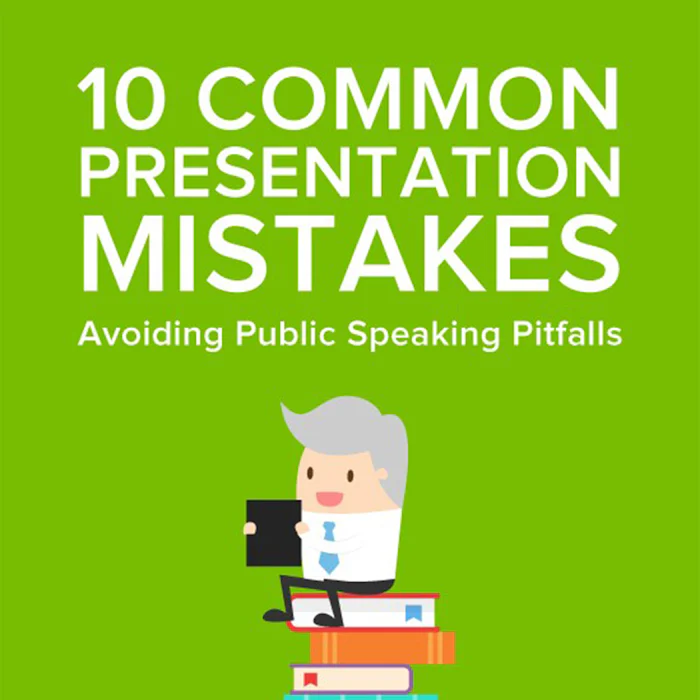
You've accessed 1 of your 2 free resources.
Get unlimited access
Discover more content
Expert Interviews
The Art of Public Speaking
With Professor Steve Lucas
Great Presentations
Add comment
Comments (0)
Be the first to comment!

Team Management
Learn the key aspects of managing a team, from building and developing your team, to working with different types of teams, and troubleshooting common problems.
Sign-up to our newsletter
Subscribing to the Mind Tools newsletter will keep you up-to-date with our latest updates and newest resources.
Subscribe now
Business Skills
Personal Development
Leadership and Management
Member Extras
Most Popular
Newest Releases

SWOT Analysis

How to Build a Strong Culture in a Distributed Team
Mind Tools Store
About Mind Tools Content
Discover something new today
Top tips for delegating.
Delegate work to your team members effectively with these top tips
Ten Dos and Don'ts of Change Conversations
Tips for tackling discussions about change
How Emotionally Intelligent Are You?
Boosting Your People Skills
Self-Assessment
What's Your Leadership Style?
Learn About the Strengths and Weaknesses of the Way You Like to Lead
Recommended for you
Outstanding 47 ways to make your organization exceptional.
John Miller
Book Insights
Business Operations and Process Management
Strategy Tools
Customer Service
Business Ethics and Values
Handling Information and Data
Project Management
Knowledge Management
Self-Development and Goal Setting
Time Management
Presentation Skills
Learning Skills
Career Skills
Communication Skills
Negotiation, Persuasion and Influence
Working With Others
Difficult Conversations
Creativity Tools
Self-Management
Work-Life Balance
Stress Management and Wellbeing
Coaching and Mentoring
Change Management
Managing Conflict
Delegation and Empowerment
Performance Management
Leadership Skills
Developing Your Team
Talent Management
Problem Solving
Decision Making
Member Podcast

How it works
Transform your enterprise with the scalable mindsets, skills, & behavior change that drive performance.
Explore how BetterUp connects to your core business systems.
We pair AI with the latest in human-centered coaching to drive powerful, lasting learning and behavior change.
Build leaders that accelerate team performance and engagement.
Unlock performance potential at scale with AI-powered curated growth journeys.
Build resilience, well-being and agility to drive performance across your entire enterprise.
Transform your business, starting with your sales leaders.
Unlock business impact from the top with executive coaching.
Foster a culture of inclusion and belonging.
Accelerate the performance and potential of your agencies and employees.
See how innovative organizations use BetterUp to build a thriving workforce.
Discover how BetterUp measurably impacts key business outcomes for organizations like yours.
A demo is the first step to transforming your business. Meet with us to develop a plan for attaining your goals.

- What is coaching?
Learn how 1:1 coaching works, who its for, and if it's right for you.
Accelerate your personal and professional growth with the expert guidance of a BetterUp Coach.
Types of Coaching
Navigate career transitions, accelerate your professional growth, and achieve your career goals with expert coaching.
Enhance your communication skills for better personal and professional relationships, with tailored coaching that focuses on your needs.
Find balance, resilience, and well-being in all areas of your life with holistic coaching designed to empower you.
Discover your perfect match : Take our 5-minute assessment and let us pair you with one of our top Coaches tailored just for you.

Research, expert insights, and resources to develop courageous leaders within your organization.
Best practices, research, and tools to fuel individual and business growth.
View on-demand BetterUp events and learn about upcoming live discussions.
The latest insights and ideas for building a high-performing workplace.
- BetterUp Briefing
The online magazine that helps you understand tomorrow's workforce trends, today.
Innovative research featured in peer-reviewed journals, press, and more.
Founded in 2022 to deepen the understanding of the intersection of well-being, purpose, and performance
We're on a mission to help everyone live with clarity, purpose, and passion.
Join us and create impactful change.
Read the buzz about BetterUp.
Meet the leadership that's passionate about empowering your workforce.

For Business
For Individuals
6 presentation skills and how to improve them

Jump to section
What are presentation skills?
The importance of presentation skills, 6 presentation skills examples, how to improve presentation skills.
Tips for dealing with presentation anxiety
Learn how to captivate an audience with ease
Capturing an audience’s attention takes practice.
Over time, great presenters learn how to organize their speeches and captivate an audience from start to finish. They spark curiosity, know how to read a room , and understand what their audience needs to walk away feeling like they learned something valuable.
Regardless of your profession, you most likely use presentation skills on a monthly or even weekly basis. Maybe you lead brainstorming sessions or host client calls.
Developing effective presentation skills makes it easier to contribute ideas with confidence and show others you’re someone to trust. Although speaking in front of a crowd sometimes brings nerves and anxiety , it also sparks new opportunities.
Presentation skills are the qualities and abilities you need to communicate ideas effectively and deliver a compelling speech. They influence how you structure a presentation and how an audience receives it. Understanding body language , creating impactful visual aids, and projecting your voice all fall under this umbrella.
A great presentation depends on more than what you say. It’s about how you say it. Storytelling , stage presence, and voice projection all shape how well you express your ideas and connect with the audience. These skills do take practice, but they’re worth developing — especially if public speaking makes you nervous.
Engaging a crowd isn’t easy. You may feel anxious to step in front of an audience and have all eyes and ears on you.
But feeling that anxiety doesn’t mean your ideas aren’t worth sharing. Whether you’re giving an inspiring speech or delivering a monthly recap at work, your audience is there to listen to you. Harness that nervous energy and turn it into progress.
Strong presentation skills make it easier to convey your thoughts to audiences of all sizes. They can help you tell a compelling story, convince people of a pitch , or teach a group something entirely new to them. And when it comes to the workplace, the strength of your presentation skills could play a part in getting a promotion or contributing to a new initiative.
To fully understand the impact these skills have on creating a successful presentation, it’s helpful to look at each one individually. Here are six valuable skills you can develop:
1. Active listening
Active listening is an excellent communication skill for any professional to hone. When you have strong active listening skills, you can listen to others effectively and observe their nonverbal cues . This helps you assess whether or not your audience members are engaged in and understand what you’re sharing.
Great public speakers use active listening to assess the audience’s reactions and adjust their speech if they find it lacks impact. Signs like slouching, negative facial expressions, and roaming eye contact are all signs to watch out for when giving a presentation.
2. Body language
If you’re researching presentation skills, chances are you’ve already watched a few notable speeches like TED Talks or industry seminars. And one thing you probably noticed is that speakers can capture attention with their body language.
A mixture of eye contact, hand gestures , and purposeful pacing makes a presentation more interesting and engaging. If you stand in one spot and don’t move your body, the audience might zone out.

3. Stage presence
A great stage presence looks different for everyone. A comedian might aim for more movement and excitement, and a conference speaker might focus their energy on the content of their speech. Although neither is better than the other, both understand their strengths and their audience’s needs.
Developing a stage presence involves finding your own unique communication style . Lean into your strengths, whether that’s adding an injection of humor or asking questions to make it interactive . To give a great presentation, you might even incorporate relevant props or presentation slides.
4. Storytelling
According to Forbes, audiences typically pay attention for about 10 minutes before tuning out . But you can lengthen their attention span by offering a presentation that interests them for longer. Include a narrative they’ll want to listen to, and tell a story as you go along.
Shaping your content to follow a clear narrative can spark your audience’s curiosity and entice them to pay careful attention. You can use anecdotes from your personal or professional life that take your audience along through relevant moments. If you’re pitching a product, you can start with a problem and lead your audience through the stages of how your product provides a solution.
5. Voice projection
Although this skill may be obvious, you need your audience to hear what you’re saying. This can be challenging if you’re naturally soft-spoken and struggle to project your voice.
Remember to straighten your posture and take deep breaths before speaking, which will help you speak louder and fill the room. If you’re talking into a microphone or participating in a virtual meeting, you can use your regular conversational voice, but you still want to sound confident and self-assured with a strong tone.
If you’re unsure whether everyone can hear you, you can always ask the audience at the beginning of your speech and wait for confirmation. That way, they won’t have to potentially interrupt you later.
Ensuring everyone can hear you also includes your speed and annunciation. It’s easy to speak quickly when nervous, but try to slow down and pronounce every word. Mumbling can make your presentation difficult to understand and pay attention to.

6. Verbal communication
Although verbal communication involves your projection and tone, it also covers the language and pacing you use to get your point across. This includes where you choose to place pauses in your speech or the tone you use to emphasize important ideas.
If you’re giving a presentation on collaboration in the workplace , you might start your speech by saying, “There’s something every workplace needs to succeed: teamwork.” By placing emphasis on the word “ teamwork ,” you give your audience a hint on what ideas will follow.
To further connect with your audience through diction, pay careful attention to who you’re speaking to. The way you talk to your colleagues might be different from how you speak to a group of superiors, even if you’re discussing the same subject. You might use more humor and a conversational tone for the former and more serious, formal diction for the latter.
Everyone has strengths and weaknesses when it comes to presenting. Maybe you’re confident in your use of body language, but your voice projection needs work. Maybe you’re a great storyteller in small group settings, but need to work on your stage presence in front of larger crowds.
The first step to improving presentation skills is pinpointing your gaps and determining which qualities to build upon first. Here are four tips for enhancing your presentation skills:
1. Build self-confidence
Confident people know how to speak with authority and share their ideas. Although feeling good about your presentation skills is easier said than done, building confidence is key to helping your audience believe in what you’re saying. Try practicing positive self-talk and continuously researching your topic's ins and outs.
If you don’t feel confident on the inside, fake it until you make it. Stand up straight, project your voice, and try your best to appear engaged and excited. Chances are, the audience doesn’t know you’re unsure of your skills — and they don’t need to.
Another tip is to lean into your slideshow, if you’re using one. Create something colorful and interesting so the audience’s eyes fall there instead of on you. And when you feel proud of your slideshow, you’ll be more eager to share it with others, bringing more energy to your presentation.
2. Watch other presentations
Developing the soft skills necessary for a good presentation can be challenging without seeing them in action. Watch as many as possible to become more familiar with public speaking skills and what makes a great presentation. You could attend events with keynote speakers or view past speeches on similar topics online.
Take a close look at how those presenters use verbal communication and body language to engage their audiences. Grab a notebook and jot down what you enjoyed and your main takeaways. Try to recall the techniques they used to emphasize their main points, whether they used pauses effectively, had interesting visual aids, or told a fascinating story.

3. Get in front of a crowd
You don’t need a large auditorium to practice public speaking. There are dozens of other ways to feel confident and develop good presentation skills.
If you’re a natural comedian, consider joining a small stand-up comedy club. If you’re an avid writer, participate in a public poetry reading. Even music and acting can help you feel more comfortable in front of a crowd.
If you’d rather keep it professional, you can still work on your presentation skills in the office. Challenge yourself to participate at least once in every team meeting, or plan and present a project to become more comfortable vocalizing your ideas. You could also speak to your manager about opportunities that flex your public speaking abilities.
4. Overcome fear
Many people experience feelings of fear before presenting in front of an audience, whether those feelings appear as a few butterflies or more severe anxiety. Try grounding yourself to shift your focus to the present moment. If you’re stuck dwelling on previous experiences that didn’t go well, use those mistakes as learning experiences and focus on what you can improve to do better in the future.
Tips for dealing with presentation anxiety
It’s normal to feel nervous when sharing your ideas. In fact, according to a report from the Journal of Graduate Medical Education, public speaking anxiety is prevalent in 15–30% of the general population .
Even though having a fear of public speaking is common, it doesn’t make it easier. You might feel overwhelmed, become stiff, and forget what you were going to say. But although the moment might scare you, there are ways to overcome the fear and put mind over matter.
Use these tactics to reduce your stress when you have to make a presentation:
1. Practice breathing techniques
If you experience anxiety often, you’re probably familiar with breathing techniques for stress relief . Incorporating these exercises into your daily routine can help you stop worrying and regulate anxious feelings.
Before a big presentation, take a moment alone to practice breathing techniques, ground yourself, and reduce tension. It’s also a good idea to take breaths throughout the presentation to speak slower and calm yourself down .
2. Get organized
The more organized you are, the more prepared you’ll feel. Carefully outline all of the critical information you want to use in your presentation, including your main talking points and visual aids, so you don’t forget anything. Use bullet points and visuals on each slide to remind you of what you want to talk about, and create handheld notes to help you stay on track.
3. Embrace moments of silence
It’s okay to lose your train of thought. It happens to even the most experienced public speakers once in a while. If your mind goes blank, don’t panic. Take a moment to breathe, gather your thoughts, and refer to your notes to see where you left off. You can drink some water or make a quick joke to ease the silence or regain your footing. And it’s okay to say, “Give me a moment while I find my notes.” Chances are, people understand the position you’re in.

4. Practice makes progress
Before presenting, rehearse in front of friends and family members you trust. This gives you the chance to work out any weak spots in your speech and become comfortable communicating out loud. If you want to go the extra mile, ask your makeshift audience to ask a surprise question. This tests your on-the-spot thinking and will prove that you can keep cool when things come up.
Whether you’re new to public speaking or are a seasoned presenter, you’re bound to make a few slip-ups. It happens to everyone. The most important thing is that you try your best, brush things off, and work on improving your skills to do better in your next presentation.
Although your job may require a different level of public speaking than your favorite TED Talk , developing presentation skills is handy in any profession. You can use presentation skills in a wide range of tasks in the workplace, whether you’re sharing your ideas with colleagues, expressing concerns to higher-ups, or pitching strategies to potential clients.
Remember to use active listening to read the room and engage your audience with an interesting narrative. Don’t forget to step outside your comfort zone once in a while and put your skills to practice in front of a crowd. After facing your fears, you’ll feel confident enough to put presentation skills on your resume.
If you’re trying to build your skills and become a better employee overall, try a communications coach with BetterUp.
Elevate your communication skills
Unlock the power of clear and persuasive communication. Our coaches can guide you to build strong relationships and succeed in both personal and professional life.
Elizabeth Perry, ACC
Elizabeth Perry is a Coach Community Manager at BetterUp. She uses strategic engagement strategies to cultivate a learning community across a global network of Coaches through in-person and virtual experiences, technology-enabled platforms, and strategic coaching industry partnerships. With over 3 years of coaching experience and a certification in transformative leadership and life coaching from Sofia University, Elizabeth leverages transpersonal psychology expertise to help coaches and clients gain awareness of their behavioral and thought patterns, discover their purpose and passions, and elevate their potential. She is a lifelong student of psychology, personal growth, and human potential as well as an ICF-certified ACC transpersonal life and leadership Coach.
The importance of good speech: 5 tips to be more articulate
The 11 tips that will improve your public speaking skills, show gratitude with “thank you for your leadership and vision” message examples, learn types of gestures and their meanings to improve your communication, make the connection: 10 effective ways to connect with people, why it's good to have a bff at work and how to find one, 6 career changes for teachers that truly pay off, member story: developing communication skills and owning the spotlight, what is a career path definition, examples, and steps for paving yours, similar articles, how to write a speech that your audience remembers, 8 tip to improve your public speaking skills, 30 presentation feedback examples, your ultimate guide on how to be a good storyteller, how to give a good presentation that captivates any audience, 8 clever hooks for presentations (with tips), communication coach: what they are and how to find one, how to make a presentation interactive and exciting, stay connected with betterup, get our newsletter, event invites, plus product insights and research..
3100 E 5th Street, Suite 350 Austin, TX 78702
- Platform Overview
- Integrations
- Powered by AI
- BetterUp Lead
- BetterUp Manage™
- BetterUp Care™
- Sales Performance
- Diversity & Inclusion
- Case Studies
- Why BetterUp?
- About Coaching
- Find your Coach
- Career Coaching
- Communication Coaching
- Life Coaching
- News and Press
- Leadership Team
- Become a BetterUp Coach
- BetterUp Labs
- Center for Purpose & Performance
- Leadership Training
- Business Coaching
- Contact Support
- Contact Sales
- Privacy Policy
- Acceptable Use Policy
- Trust & Security
- Cookie Preferences

10 Ways to Avoid Presentation Failure
April 28, 2023
We’ve all sat through bad presentations – the kind that make you want to check your email or scroll through your social media. Maybe you’ve even had a presentation failure at work.
But why do some presentations fail to engage and inspire, while others leave a lasting impression , preparing a business presentation is a real skill; a core business skills. and it’s a skill you can learn. over the last 15 years we’ve coached thousands of people to be brilliant business presenters. , do please call us and we’ll tell you about our business presentation coaching – it’s fast and good value., in the meantime, we share the top reasons for bad presentations, with tips on how to avoid the fails., here are 10 reasons for presentation failure.
Let’s review each of these reasons in more detail:
1. You don’t prepare enough
If you haven’t put in the time to research and rehearse your presentation, it will show. You’ll deliver a bad presentation. You may fail to land your message, stumble over unfamiliar words, or struggle to answer questions from the audience. Make sure you give yourself enough time to prepare and practice to avoid presentation failure.
2. You have a poor structure
A poorly structured presentation can leave your audience floundering, unable to follow your train of thought, leaving them bored and disengaged. Take time to plan. What’s the overarching message or purpose? What are your key points and are you providing clear evidence for each one? Does your presentation have a logical flow? And, most importantly, do you start with a powerful opening and close strongly?
Contact us for a free consultation on your coaching needs
3. Over-reliance on slides
Slides can be powerful visual aids, but if you rely on them too heavily, you are on track for a presentation fail. Slides should support your presentation, not drive it. You should be the focus of the audience’s attention, not your PowerPoint deck.
Perhaps you don’t even need slides at all – many business leaders never use them. Or think about what other visual aids you could use instead – powerful pictures, physical products, films or flip charts.
4. Lack of energy and enthusiasm
If you’re not excited about your presentation, your audience won’t be either. If you look bored, they’ll feel bored. Make sure you bring energy and enthusiasm to your talk. Smile, make eye contact, use a strong and confident voice.
Show that you’re passionate about your topic, that it’s important to you, that you believe what you’re saying. Your enthusiasm will be contagious – and it will help you carry your audience with you.
5. Ignorance of your audienc e
Have you thought about what your audience really wants and expects from your presentation? What’s in it for them? If you don’t take the time to understand their needs and interests, you’ll lose them. If you lose your audience you’ll have a presentation failure.
Instead, carefully consider what matters to them, show you care about them. Use language and examples that resonate with them.
6. Too much jargon
Jargon and technical language can be confusing and off-putting for your audience, especially if they’re unfamiliar with your business. A typical bad presentation includes too much industry-specific jargon, acronyms and technical terms.
The best presentations use simple, clear language. Sometimes it helps to imagine that you’re a teacher, explaining difficult concepts to a teenager. If your 15-year-old niece or nephew grasps your story, so will everyone else.
7. Lack of engagement
Making an emotional connection with your audience can often make the difference between a successful presentation and a failed presentation.
Try asking questions, soliciting feedback and encouraging participation. Get your audience involved. Make them feel engaged.
8 . You are too formal in your presentation
Your presentation should reflect your personality and individual style. If you’re too formal or stiff, it will feel as if you’re holding your audience at arms’ length, lecturing rather than informing them. Be authentic and let your personality shine through.
9 . Irrelevance
There’s no point giving a technically brilliant presentation if it’s out of date or simply not appropriate for your audience. Your material should be relevant and timely. Keep it as topical as possible. Use up-to-date data, anecdotes and examples.
Avoid talking about things that may be interesting in their own right, but have no relevance to the subject of your presentation – or your audience may simply tune out.
10. No clear call-to-action
It’s important you’re clear about what you want your audience to do, think or feel at the end of your presentation. A clear call-to-action is always the best way to close. It may be that you want them to buy into a big change in your business, or take part in a survey. Or you may just want to challenge them to think differently about something, or make a change in their behaviour. To avoid bad presentations make sure your audience knows what you want them to do – and make it easy for them to do it.
How to be sure your presentation does not flop
Discover why presentations fails and avoid failed presentations.
How to Make Sure Your Presentations Don’t Flop
Great presentations take careful planning and preparation. By avoiding these 10 common pitfalls, you can create something that engages, informs, and inspires your audience. You’ll avoid a failing presentation at work.
Remember to focus on their needs, inject energy and enthusiasm. Start strong and end with a clear call-to-action. With these simple tips, you can ensure your presentation doesn’t flop, but leaves a lasting impression.
Transform your presentation skills with tailored coaching

We can help you present brilliantly. Thousands of people have benefitted from our tailored in-house coaching and advice – and we can help you too .
“I honestly thought it was the most valuable 3 hours I’ve spent with anyone in a long time.” Mick May, CEO, Blue Sky
For 15+ years we’ve been the trusted choice of leading businesses and executives throughout the UK, Europe and the Middle East to improve presentation skills and presentations through coaching, training and expert advice.
Unlock your full potential and take your presentations to the next level with Benjamin Ball Associates.
Speak to Louise on +44 20 7018 0922 or email [email protected] to find out more and discuss transforming your speeches, pitches and presentations.
Or read another article..., how to sell your business: 9 success secrets.
Get the best value when you sell your company Embarking on the journey…
How to Write a Presentation: Expert Guide for Business
PowerPoint Presentations can be great. Or they can be crap. We all know…
Storytelling in Business Presentations – 10 top tips for 2024
No matter what the topic of your next speech or presentation, if you…
What is Presentation Coaching? The best way to improve your presentation skills
I am sure, if you have ever thought about presentation coaching, you will…
Contact us for a chat about how we can help you with your presenting.
What leaders say about Benjamin Ball Associates
Manager, ubs.
"Essential if you are going to be a spokesperson for your business"
Senior Analyst, Sloane Robinson
"Being an effective communicator is essential to get your stock ideas across. This course is exactly what's needed to help you do just that!"
CEO, Blast! Films
“Our investment in the coaching has paid for itself many times over.”
Ed Coulthard
Corporate finance house.
“You address 95% of the issues in a quarter of the time of your competitor.”
Partner International
“Good insight and a great toolbox to improve on my presentations and delivery of messages to not only boards, analysts and shareholders but to all audiences”
CEO, Eurocamp
“We had a good story to tell, but you helped us deliver it more coherently and more positively.”
Steve Whitfield
Ceo, ipso ventures.
“Ben did a great job on our presentation. He transformed an ordinary set of slides into a great presentation with a clear message. Would definitely use him again and recommend him highly.”
Nick Rogers
“Moved our presentation into a different league and undoubtedly improved the outcome and offer we received.”
Head of IR, Equinox
“A fantastic job reviewing and transforming our marketing material and helping us get our message across with clarity to potential investors.”
Sylvie Armand Delille
Let's talk about your presentation training needs, +44 20 7018 0922, [email protected], our bespoke presentation coaching services, investor pitch coaching, executive presentation coaching, public speaking training, executive media training, new business pitch coaching, privacy overview.
- SUGGESTED TOPICS
- The Magazine
- Newsletters
- Managing Yourself
- Managing Teams
- Work-life Balance
- The Big Idea
- Data & Visuals
- Reading Lists
- Case Selections
- HBR Learning
- Topic Feeds
- Account Settings
- Email Preferences
What It Takes to Give a Great Presentation
- Carmine Gallo

Five tips to set yourself apart.
Never underestimate the power of great communication. It can help you land the job of your dreams, attract investors to back your idea, or elevate your stature within your organization. But while there are plenty of good speakers in the world, you can set yourself apart out by being the person who can deliver something great over and over. Here are a few tips for business professionals who want to move from being good speakers to great ones: be concise (the fewer words, the better); never use bullet points (photos and images paired together are more memorable); don’t underestimate the power of your voice (raise and lower it for emphasis); give your audience something extra (unexpected moments will grab their attention); rehearse (the best speakers are the best because they practice — a lot).
I was sitting across the table from a Silicon Valley CEO who had pioneered a technology that touches many of our lives — the flash memory that stores data on smartphones, digital cameras, and computers. He was a frequent guest on CNBC and had been delivering business presentations for at least 20 years before we met. And yet, the CEO wanted to sharpen his public speaking skills.
- Carmine Gallo is a Harvard University instructor, keynote speaker, and author of 10 books translated into 40 languages. Gallo is the author of The Bezos Blueprint: Communication Secrets of the World’s Greatest Salesman (St. Martin’s Press).
Partner Center
Riklan Resources Resume and Career Services
- Testimonials
- News and Events
- Resume Services
- Executive Resume Writing Service
- Resume Packages
- LinkedIn Profile Writing
- Professional Resume Examples
- Career Services
- Training Workshops
- Teambuilding
- Communications
- Customer Service
- Empowerment
- Public Speaking
- Sexual Harassment
- Supervisory
- Conference Speaker
- Conducting Effective Performance Reviews
- Effective Interviewing
- It’s OK to be the Boss
- Leading the Way with Emotional Intelligence (EI)
- Managing Your Success
- Situational Leadership II
- The Leadership Challenge® Workshop
- Resource Center
- Custom Services Payment
- Corporate Outplacement
- National Career Summit
- Supported Products
- Guest Posting Guidelines
- Video, Audio & Print
6 Reasons Your Presentation Didn’t Go as Well as You Imagined

You’re accustomed to giving presentations. You felt well prepared, you knew your notes well enough not to have to read from them, and you weren’t nervous.
Your voice was confident, and you checked to make sure that it carried across the room. Yet, you feel the presentation could have been better. As you glanced around the room, you noticed that people were looking at their phones and the clock, playing with their empty coffee cups, and generally looking uninterested in what you had to say.
Your presentation tanked. Big time.
I’ve got news for you. It takes more than knowing your notes to give a stellar presentation. The fact is that most people go to so many conferences and hear so many talks that they now have a higher standard for speakers.
Time is valuable, and there are so many speakers and so many forms of media. Besides, the Internet (think TED Talks) has afforded us access to speeches from all around the world. People want to get their money’s worth when sitting down to hear someone speak. For your part, that means going above and beyond.
Today, we’ll discuss six reasons why your presentation may have tanked.
- Outdated Information
People have all kinds of access to information these days in comparison. Journals, magazines, conferences, the Internet and books are all options. If you’re going to give a talk on any subject, you need to give people new information—a new study, article, survey, or discovery that’s not yet widely disseminated in that industry.
Information that is inaccurate or outdated won’t help them.
- Criticizing Competitors or Others
Criticizing your competitors not only makes you look rude, it makes you look insecure. Besides, playing fair is classy. Slagging your competition or anyone who isn’t there to defend him or herself is not. Always focus on your own game, and be confident in your own abilities.
Don’t criticize someone else in your industry just because your opinions differ. Even if you have evidence to suggest he or she is wrong, it’s best not to discuss this in a speech. In most events, your audience is expecting an educational talk, not a rant.
- Not Researching Your Audience
Yes, I meant the people who will attend your talk. Not the subject of your presentation.
When it comes to speeches, one size does not fit all. Different audiences call for different nuances to your speech. You may have the same material, but can put it 101 different ways to make it more suited for your audience, so that they can get the most out of it.
A talk on negotiating a job offer will be different for fresh graduates than for executives’ right? The subject will be different, but so will the possible questions, attention span, interests, and challenges of the people listening to you.
- Reciting Too Many Facts without Rhyme or Reason
When you have too much data and information, it makes your audience members’ heads swim. Nobody can absorb that much information.
Your presentation isn’t a textbook that they can go back and re-read – the idea of a presentation is to give the highlights and to give your audience ideas and things to ponder. Consider putting in stories to connect the seemingly random facts and figure together.
- Scope out the Venue
Your speech should take into account whether you’re giving the presentation in an intimate setting for an audience of 15, or in an auditorium for 500 guests. Consider making the intimate presentation interactive, and make sure your message is broad enough to cater to the varying interests of the 500 people.
- Abrupt Endings or False Endings
Some things are best left a mystery – Santa Claus, the Caramilk Secret – but not the end of your presentation. People won’t know whether to applaud or wait for more, so you’re left with an awkward silence.
Have you ever had a presentation that could have done better? Think of the presentation and reread the tips. Is there something you could have changed?

Our Credentials, Awards and Affiliations
Discover the ultimate job search course.
HIRED! is a proven, step-by-step job search course designed to empower you to land a job faster!
E-Mart Blog
Emily Martin's Blog for Leaders

- Spring Term: Week 1- Why are you here and where are you going?
- Spring Term: Week 2- Words that empower you
- Spring Term: Week 3- Visit to Intel
- Spring Term: Week 4- Achieve the Present and Focus on the Future
- Spring Term: Week 6 – Networking is key
- Spring Term: Week 7 – THE Elevator Pitch
- Spring Term: Week 8 – A Sticky Story
- Week 1: Surround yourself with…. Leaders
- Week 3: How do you lead?
- Week 4: Always Examine the Positive and Negatives of Your Actions
- Week 6: Scavenging for Leadership Traits
Week 9: The Presentation I Didn’t Go To…
Todays topic is regarding how to influence others by your leadership. The task of the week was to present to 8th graders and give them the basic understanding of business and the different concentrations of business. In our Building Business Leaders class, we were tasked with breaking up the parts of the presentation and coordinating with each other to make sure everything got done. It was actually like Tayah was simulating an actually business for us. We all had our own parts and we have to work together to produce a presentation to pursue our target market (the 8th graders) to look into studying business in the future.
Even though I was not present for the presentation, I heard from my peers that the presentation went quite well. I personally liked the idea of the activity of the shoes and how to convince the students to be entrepreneurial to create their own sneakers. I heard that everyone did their part and the presentation got done with ease. So of the parts of the presentation that I heard didn’t go so well is the actually oral presentation. The preparation of the oral presentation had not been practiced so some of the presenters had to wing it on the spot. If I could do the presentation again, I would probably want to be there do I can actually see the presentation. What I believe the group could have done differently is work on the presentation a little bit sooner and not procrastinate as much. The group kind of put it off until the last two days before the presentation.
If you had to do a business presentation in front of 8th graders, what would you do? Do you think the leadership styles of everyone in the group would clash? Ponder those questions!
Thanks guy for a great term,
Leave a Reply Cancel reply
Your email address will not be published. Required fields are marked *
Save my name, email, and website in this browser for the next time I comment.
Member Login
- Lost your password? | Create a new account
Recent Articles
- Spring Term: Week 5 – Experiences shape us all
Popular Tags
Recent comments, most commented, sidebar widget.
- All you need to do is to visit your widget tab replace this with your widget
DISCLAIMER: This site is maintained for personal and professional communications as authorized by the University of Oregon's computer use policy. Unless otherwise indicated, the content and opinions expressed on this web site do not necessarily reflect the views of nor are they endorsed by the University of Oregon or the Oregon University System.
My Meeting Didn’t Go Well. Now What?
“My meeting didn’t go well.” Now What?
That may sound like one thought. But, it’s actually two different perspectives. It’s our clients who say, “My meeting didn’t go well.” And it’s me who asks: “So, now what?” What did you do to follow up?
The reply is often: “Nothing.”
Because when a communicator has invested a lot of time and effort to lead a conversation or present a new idea and it doesn’t go well, the emotion they feel is…well, at least it’s over. It’s behind me. And, I don’t have to do that again for 90 days. Whew!
It’s an understandable feeling, but a short-sighted one.
As roles expand, managers, directors and new VPs, are handed more responsibility. And with responsibility comes visibility. That’s a great thing because exposure leads to connection with senior leaders and future opportunities. But it also gets harder because topics are more complex, and recommendations are not so black and white.
In our research on executive conversations, we consistently hear that experienced communicators say conversations with leaders only reach their intended result 60% of the time. That means 40% of the time, the communicator doesn’t get a desired takeaway or result.
Whether your batting average is a little higher or a little lower, the reality is no one hits the mark every time. So, you need to know what to do when things get off course.
And, the answer begins by understanding what happens on the other side of the conversation.
The leader notices that you weren’t on top of your game or didn’t walk out with an approved next step. They may be surprised that you missed the mark if they’ve experienced a more successful conversation with you. Or, they may not know you and this may be their first impression. Whether it’s a first impression or a different one, they take note. And, they hold onto that impression.
In fact, anyone would. Your peers or employees would notice a conversation that didn’t yield takeaways. What’s different with a senior leader is that their experiences of you are not as frequent. So, their impressions last longer. Impressions last until they meet with you again or get the next report out. So, the power of an impression becomes more significant because they don’t see you the next day like a peer or an employee would. Instead, they hold onto those impressions, and over time impressions can become distorted.
We know this because we capture feedback from leaders who often say: “When I think about Joe as a communicator, I remember a meeting last year.” Or, “Sue seems like a sincere person, but she just can’t anticipate my questions well.” And, the follow-up phrase is often: “I just can’t get what I need from Sue. She’s not ready to lead this kind of discussion.” or, “Joe needs to lift the altitude of his conversations. He doesn’t know how to focus on what I need.”
And, those are impressions and comments that you need to diffuse. So, what do you do when meetings don’t go well? Three things can help a communicator move beyond a bad experience.
Acknowledge it. As much as you’d like to walk out and forget it ever happened, you need to acknowledge that it didn’t go well. Leaders worry most about whether someone is aware of mistakes. Notice in the quotes: “She’s not ready …” and “He doesn’t know …”. It’s the lack of awareness that sets up concern more than the miss itself.
Within 48 hours, send an email and acknowledge that you missed a point or fell short of having needed information. While the impression may not fade entirely, it’s now blended with an impression of awareness that gets high marks.
Answer it. Most misses are caused by questions that can’t be answered in the meeting or perspectives that were too far apart to find common ground. The solve is usually new information or a repositioning of information. Work quickly to get new information in front of the leader before they lose track of the topic. When you circle back with information, don’t dwell on the solution that you started with and avoid being defensive about the information you initially presented. Provide context to reset the topic and focus on moving the conversation forward.
If you can combine the answer with the acknowledgment, all the better. But if not, send an email to acknowledge and commit to a deadline of when the leader will have the correct information.
Check on it. The two steps above represent a lot of effort to reset a poor impression, and they work. But it’s always a good idea to circle back and confirm that the poor impression didn’t stick. This is your brand, not just a presentation. Use your manager to check on impressions. Ask if the leader has moved beyond the impression. In most cases, you’ll get good insight in return.
If you don’t have an easy way to assess impressions, watch for indicators of impressions. Are you taken out of senior-level meetings or presentations? Do you not get as much visibility as you once did? Is someone else reporting out on your initiative? Those are negative indicators. Or, did the conversation reset and move forward? Are you given added responsibilities and visibility? Those are possible indicators.
The reality is that an increase in visibility means an addition in complexity. These conversations aren’t easy, but they shouldn’t be risky. Nobody’s perfect, and nobody is expected to be. But, if your success rate is only 60%, you may need to improve your batting average.
And that’s where we can help. Hitting the right altitude and providing information that leaders value is a methodology we teach in our Leading Executive Conversations program. From how to recover a miss to improving the odds of success, we can help you improve consistency and outcomes.
Call us when you need us.

- Our Methodology
- Tailored Coaching Programs
- Open Programs Overview
- Connecting Stories to Storylines
- Leading Executive Conversations
- Strengthening Personal Brand & Impressions
- Mastering Executive Presence
- The Virtual Communicator
- The Master Storyteller
- Stewarding Your Career
- Manager to Leader
- Delivering Effective Feedback
- Handling the Q&A
- Individual Coaching
- Event Speakers
- Communication Coaching
- Corporate Strategy
- Customer Success & Experience
- Data & Analytics
- Finance Teams
- Information Security & Technology
- Marketing Specialists
- Sales Teams
- Supply Chain
- Talent Development
- Career Development Map
- Peak Career
- Early Career
- Our History
- SW&A Advantage
- SW&A University
- What’s Your Story Podcast
- Books by Sally Williamson
- SW&A Video Programs
- SWAU Membership
InfoQ Software Architects' Newsletter
A monthly overview of things you need to know as an architect or aspiring architects.
View an example
We protect your privacy.
Facilitating the Spread of Knowledge and Innovation in Professional Software Development
- English edition
- Chinese edition
- Japanese edition
- French edition
Back to login
Login with:
Don't have an infoq account, helpful links.
- About InfoQ
- InfoQ Editors
- Write for InfoQ
- About C4Media
Choose your language
Discover new ideas and insights from senior practitioners driving change in software. Attend in-person.
Discover transformative insights to level up your software development decisions. Register now with early bird tickets.
Get practical advice from senior developers to navigate your current dev challenges. Register now with early bird tickets.
Level up your software skills by uncovering the emerging trends you should focus on. Register now.
InfoQ Homepage Articles The 4 Questions of a Retrospective and Why They Work
The 4 Questions of a Retrospective and Why They Work
Jul 08, 2013 11 min read
Laura M. Waite
Collin Lyons
InfoQ Articles Contest
How to improve your team productivity.
Retrospectives are used frequently to give teams the opportunity to pause and reflect on how things have been going and then, based on those reflections, identify the improvements they want to make. Conducting Retrospectives frequently and regularly supports a team to continuously improve their performance - but what’s the best way to go about it? We have four simple questions to get you started...
How to Get the Most out of your Retrospectives
Numerous approaches are used for Retrospectives. Some are longer and aim to mine the group’s experience; some take a quantitative look at the team’s history; still others use exercises to incorporate fun into the event, and the team itself. At the root of what we want to do, however, is team productivity improvement so the technique we turn to most often is “The 4 Questions” - a quick and easy approach that guarantees your team will be improving immediately. We provide a handy step-by-step guide on how to run a 4 Question Retrospective on our website. In this article, we’re going to explain the importance of the four questions and how to make sure that you’re getting the most value you can from your team retrospectives. In short, a 4 Question Retrospective gets the the team to reflect on the last, short period of time working together (often 2 weeks) and answer four specific questions:
- What went well?
- What didn’t go so well?
- What have I learned?
- What still puzzles me?
And then, based on the answers, the team will decide on actions to improve in the future.
Related Sponsored Content
Sounds simple, right? It is. But as with all things simple, it’s not necessarily easy. In our experience, understanding the background of the technique and the importance of the wording of the questions, helps teams immensely in getting real value out of their retrospectives.
Where Do Retrospectives Come From?
Retrospectives are popular in the team-working world of the Lean & Agile community but the technique was inspired by the wonderful work of Virginia Satir , the “mother of family therapy”. She developed a technique called the Daily Temperature Reading, aimed at keeping relationships healthy and happy. Her questions were different, but the core of the method is first reflecting on what has happened in the past (both positive and negative) and then deciding on what to do in the future to improve.
We Look at the Past to Improve the Future
Before we delve into the specifics, it’s important to note that, when we’re answering these questions, we must always be looking at the past. The four questions themselves address the looking back part of the process - we’ll tackle the looking forward part (actions to embed improvement) at the end of this article. Each of these four questions plays a vital role in understanding how things went for the team in working together. Retrospectives are about improving the way teams are working - both what we do and how we do it - which will become even clearer as we elaborate on what each question is designed to focus us on...
The 4 Question Retrospective
Question 1: what went well.
In the quest to make improvements, it’s natural to focus on pain points: things that didn’t go well. But asking ourselves what went well starts the Retrospective on a positive note and allows us to acknowledge all the good things that have happened, too.
The Importance of Positivity
Why is this important? First, because it’s healthy to take the time to recognise all is not doom and gloom. Noticing the positive can help to balance out the negative. Second, by explicitly acknowledging the positive, we have the opportunity to be deliberate in ensuring we continue to do what we need to do to keep those positive things happening. Some examples of things that have gone well might be:
“Talking with the customer gave us insights we hadn’t noticed ourselves.”
“By seeing what each of us was working on, we avoided some tasks that would have been wasted.”
“Our project sponsors were impressed with the presentation.”
Think Big and Be Specific
It’s not unusual for teams to think big with this question and talk about the project as a whole (and we fully support that!), but it’s also important to dig deeper, potentially surfacing more of the details. For example, “It helped me immensely when Sharita took 5 minutes to talk me through how to make the posting”. Throughout your respective, it’s good to focus on both the big picture and the low-level details of what has happened.
Question 2: What Didn’t Go So Well?
This question unearths difficulties, issues and dissatisfactions that the team are currently grappling with. It’s often the most popular question, which shouldn’t be a surprise since the purpose of the exercise is improvement. Where better to look to make improvements than where things are not going well?
The intention of this question is to identify things that happened which someone in the team thinks were less than ideal. In answering this question, it’s important that we focus on things that actually happened - reflecting on the past and what did occur. For instance, “We spent a long time making the decision on the ordering process” rather than, “It shouldn’t take us so long to decide the ordering process”.
The distinction is subtle, but significant. The first version states an observation of something that didn’t go well, which invites the question “How could we improve that?”, while the second version implies a judgement as well as a preferred solution. The first version, which looks back on the past and states what actually happened, puts us in the right mindset for making improvements.
Observations on the Past Create Opportunities for the Future
Notice the difference between these two statements,
“Two pieces of work were rejected by our customer,” instead of “I wish our customer was more realistic about what we can deliver.”
Again, the first version is a simple observation. There are two issues with the second: it states a desire for the future, not an observation about the past, and it implies a single solution, which may or may not solve the actual problem. We want to avoid identifying solutions at this stage because doing so can limit our thinking on our options. By just noting the facts, we leave more room for deciding how we want to make improvements.
Focus on the Facts
One more example could be, “Our Tuesday meetings are running over time” rather than “We keep getting bogged down in detail during the Tuesday meetings”
Our meetings may be going over time because we’re getting bogged down in details, and certainly that could seem like the right answer for the one person in the room who is a manager and thus may be less interested in details. The rest of the attendees, however, may be finding the detailed conversation the most salient point of the meeting. Being clear about the problem we wish to address (of which there is only one), rather than our preferred solution (of which there are many options), keeps the focus on the problem and opens up a myriad of possible solutions. Focusing on expressing the facts goes a long way to improving the outcome of a team’s retrospectives.
Keep the Team Positive
The final, but arguably most important, distinction between the statements presented has to do with the power of keeping the team positive. As humans, most of us thrive on looking at facts and solving problems. Equally, many of us lose energy when faced with arguments, confrontation and differing opinions of the same event. Why not keep everyone’s energy up in the room by focusing on what actually happened? As you know, a positive, happy team motivated by their own forward progression is a tremendous force!
Question 3: What Have I Learned?
This is a powerful question and reflecting on it tends to open our minds to things we might not otherwise take notice of. It encourages us to look at what we’ve learned about the way we’re working. Some examples might be:
“I’ve learned that it works better to get away from the keyboard when I’m thinking through a tough issue.”
“I’ve learned that I get less distracted if I’m clear about what I want to accomplish before I sit down at the computer.”
“I’ve learned that providing context up front improves how my message is received in a presentation.”
Of course we can learn negative things too, such as: “I’ve learned that making last-minute changes isn’t worth the risk.”
Embed your Learning in the Team
This question brings to our attention, and thus reinforces, what we’ve learned. It also opens up the potential for others to make use of that learning, either by identifying an action to engrain the learning in the way that the team works (more about that in a moment!) or by simply voicing it, allowing others to decide if they’d like to individually try it out.
Question 4: What Still Puzzles Me?
Puzzles and open questions are almost the opposite of the previous question. This question liberates us to express things we wish we had the answers for, but don’t. Some examples might be:
“Why are we attracting fewer and fewer people to our product demonstrations?”
“Why is doing my work taking twice as long as it did last week?”
“Where does our product fit into the overall portfolio strategy?”
As you can see, these puzzles express a question we have - a gap in our knowledge. This is also a fantastic opportunity to express concerns, misgivings, doubts or other sensitive topics because you can draw attention to your worry without making a statement. A question, after all, is more likely than a statement to spurn thoughts, insights and a positive outcome from everyone involved.
Questions Build Participation
Take for example, the difference between the question, “How can we improve the flow of requests between us and the sales team?” and the slightly more aggressive tone of the equivalent statement: “The sales team are demanding too much work, too quickly, for us to keep up with”. Top Tip: At your next retrospective, you may want to consider trying to change your answers to “What Didn’t Go So Well?” into puzzles. We bet you’ll find it generates more buy-in and participation. Virginia Satir was one smart cookie when she designed the 4 Questions technique!
Turning the 4 Questions into Improvements
By the time we’ve answered The 4 Questions, we have some insight into what happened over the time period we’re reflecting upon; the next step is to identify the actions we want to take to be sure that we improve in the future. Knowing that there’s only so much time available to devote to making improvements, we recommend that teams take on only a small number of improvements at a time. The simplest way of achieving this is to have the team review the answers to all four questions and identify the top three items to address in terms of importance and value. For some items, the team will want to take time to root out the cause of the situation. For example, we may decide it’s important or valuable to resolve this statement: “We spent a long time making the decision on the ordering process”. After a brief discussion, we might determine that access to a specific person could accelerate our discussions. Thus, the action might be to see if we can get access to that person the next time we need to make decisions about the ordering process. If the team were to decide that it’s important or valuable to resolve this puzzle: “Where does our product fit into the overall portfolio strategy?”, the team might decide to arrange for the portfolio manager to give a presentation about the product portfolio and how the product fits into the long-term strategy.
How Can You Improve Your Working Environment?
Now that you know all of this, you may be wondering how to introduce all of this knowledge into your team. Grand question! Here are some tips that we’ve used in the past, which we hope will help you to improve your working environment today:
If your team needs to improve their retrospectives, consider requesting 20 minutes at the beginning of your next session to have everyone read over this article and discuss their thoughts.
If you’ve never done a retrospective with your team, start today! To learn more tips and tricks for running a successful Retrospective, check out our Tuesday Tip series on Sending Your Team’s Productivity Soaring With Retrospectives !
There’s good reason for the popularity of Retrospectives, both within the Lean & Agile and software development communities and in the wider business community: they provide a simple, easy-to-adopt technique for coaxing valuable improvements from a team on a regular basis. Sticking points, positive working methods, hidden problems, potential improvements: all of these and more can be discovered using The 4 Questions, catapulting your team to new heights of productivity and effectiveness. Virginia Satir, we salute you!
About the Authors

Rate this Article
This content is in the agile topic, related topics:.
- Culture & Methods
- Retrospectives
- Continuous Improvement
- Agile Techniques
Related Editorial
Popular across infoq, will c++ become a safe language like rust and others, qcon london: meta used monolithic architecture to ship threads in only five months, architecture does not emerge - a conversation with tracy bannon, architecting for high availability in the cloud with cellular architecture, architectures you’ve always wondered about 2024 emag, java news roundup: new jep candidates, project bisbane, ktor plugin repository, jdkupdater, related content, the infoq newsletter.
A round-up of last week’s content on InfoQ sent out every Tuesday. Join a community of over 250,000 senior developers. View an example
The Throughline Blog
Practical Media Training and Public Speaking Tips
My Speech Didn’t Go Well. Now What?
A reader emailed me about a very challenging situation she recently faced:
“I gave a presentation to an industry group a few weeks ago. At the time, I thought it went well. I recently got the survey/feedback and there were some very nasty comments. Here’s the thing. The night before the presentation, I found out that my uncle had gone into cardiac arrest and that he was dying. Needless to say, I was incredibly shaken and upset. I did not sleep much (maybe two hours), so when I got to the event, I was exhausted, stressed and sad, and really not close to being at my best. I did not disclose any of this to the audience or the organizers. I am doubly upset now because I feel that with those types of reviews I will never get a chance to present at this industry event again. It’s like a huge black mark…and perhaps if I had explained myself, I would have gotten more of a pass. Plus, it’s really shaken my confidence.”

She posed the following questions:
“If you have had a bad situation like mine, should you a) cancel the presentation because you know you are not going to be able to do a good job or b) disclose the situation (if so, how much detail?) or c) none of the above? What do you recommend?”
1. Assess Whether To Proceed
It’s easy to suggest that you shouldn’t speak if you’re in a heightened state of emotional turmoil—but it’s not always so easy to cancel if it means leaving an audience or conference planner in the lurch. As I mentioned in a post last week, there are times when it’s easy for conference planners to reverse a slot or fill your slot with another speaker. If that’s the case, canceling or delaying might have been the best way to proceed. But my personal belief is that outside the most extreme situations, when an audience is depending on you, the show must go on. Each speaker has to decide for him or herself what constitutes an “extreme” situation.
2. Don’t Disclose To The Audience
In the post last week, I wrote: “There’s no reason to let your audience know that they’re not seeing you at your best, and they’ll feel cheated if you do.” Even in a situation like this, once you hit the stage, your sole focus should be on fulfilling their needs, not making excuses (reasonable as they would be, in your case) for your performance.
3. Contact The Conference Planners
Let’s look forward for the rest of this post. I suggest you contact the conference planners. Explain the situation to them, that you agree with the negative reviews, and that you’d like an opportunity to redeem yourself at a future event. You might request a less prestigious speaking slot or a slot with fewer attendees as a way to “prove yourself” while helping them feel more comfortable with the risk.
4. Take an Honest Look at the Reviews
Strip out the negative, accusatory, or hostile language in the comments you received, and take a hard look at the messages behind them. Do the criticisms have merit? If so, how much of them are about your general speaking style vs. your style on just that day? If the comments only seem to apply to your one “off” day, you can dismiss them. If you think they could apply to your general speaking style, look for ways to improve in those areas.
5. Continue to Improve
Join a Toastmasters chapter. Take a Dale Carnegie speaking course (or, look for mine sometime in the next few months!). Read public speaking books ( here are a few good ones ). Practice using a video camera and watch back your practice speeches ( more on how to practice here ). And please don’t take this suggestion as an accusation that you’re not a good speaker; think of it this way: even star athletes take extra practice swings or shoot practice free throws.
6. Record Your Next Presentation
The next time you speak to a group in public, set up a small video camera in the back and record yourself. Watch the tape back afterward to see what worked and what didn’t. This step is slightly different than the advice offered in the previous point, since this is suggesting you tape and review your actual speech, not just the practice speech.
7. Most Importantly, Don’t Bring The Past Into The Present!
The next audience you speak to has no clue that your last speech didn’t go well. So even though you might be feeling insecure or particularly anxious going into your next presentation, approach the new audience as a brand new one. It is. They don’t know the back story here—and they won’t know it unless your insecurity gets the best of you. Change your interior monologue from “I hope I don’t screw this one up like last time” to “I know I’m a good speaker and I’m going to give these people a great presentation they can use to improve their lives.”
I’m sorry you faced such a tough situation, and my condolences on your loss. Treat this situation as a one-time event. And as you reflect on that experience, do everything you can to avoid making it a larger referendum on you or your speaking style. Good luck!
Do you have any additional advice or feedback for this reader? If so, please leave it in the comments section below.
- presentation training
- public speaking
Share this article
- Share on Facebook
- Share on Twitter
- Share on LinkedIn
- Share on Email
STAY UP TO DATE WITH THE THROUGHLINE NEWSLETTER
Join the thousands of professionals who receive our email newsletter. Improve your public speaking and media interviewing skills—and enhance your career— by signing up.
Public Speaking Skills Training
Since 2004, we have helped speakers prepare for the world’s biggest stages, including TED, the World Economic Forum, and a presidential announcement speech. We’re committed to your long-term growth, and we’ll be with you every step of the way.
More from the throughline blog

In Presentation Training How to Hide a Lavalier Mic Wire

In Presentation Training Are Your Stories Making You Appear Inauthentic?

In Presentation Training Why You Should Have Three Speech Opens
This website or its third party tools use cookies, which are necessary to its functioning and required to achieve the purposes illustrated in the privacy policy . If you want to know more or withdraw your consent to all or some of the cookies, please refer to the privacy policy. By closing this banner or continuing to browse otherwise, you agree to the use of cookies.

Try for free
What Went Well
What went well ideas and examples in an agile environment, when to use what went well, pros and cons of what went well, template for using what went well, what went well definition.
What Went Well is a retrospective technique that serves a crucial role in the agile methodology and has become widely used in the agile community. It is one of the best opportunities for both remote and in-office teams to analyze any potential improvements by asking two (seemingly simple) questions: what went well and what didn’t go so well?
How To Use Customer Feedback for Business Growth

.css-uphcpb{position:absolute;left:0;top:-87px;} How do you organize What Went Well?
In order to start a What Went Well retrospective, the facilitator in charge should present how the method works. Then, they should tell the team that the total time limit is 30-60 minutes, depending on the size of the team. Before moving further, make sure everyone understands the technique and that they feel comfortable proceeding.
The next step should not take more than 15 minutes, as you ask all participants to answer the questions “What Went Well?” and “What Didn’t Go Well?”. They should write one idea per sticky note and a record should be kept. At this stage, team members should continue to keep their thoughts private, as it is important for everyone to have their own ideas without being influenced by their peers . Once time is up, all members’ notes are organized by which question was being answered .
The third step should take a maximum of 10 minutes — it’s time for theming . Often, the output notes will be similar in topic or theme. So, during this time, all participants should collaborate to group the notes into appropriate buckets. This is done to save time during the next step and ensure all themes are covered.
If the discussion topics are not obvious, the facilitator can opt for a dot-voting session. This way, each participant receives a number of votes they can allocate based on which subject they deem worthy of prioritization .
The next step is to discuss the topics under each question. Depending on team size, anywhere between 20 to 40 minutes should be allocated. If dot-voting wasn’t used, the order of discussion can be chosen by the facilitator. It is important to frame each subject into a timebox so the conversation can move at a faster pace.
During the discussion, all team members need to keep in mind that they have to present the positive side of what went well, but also come up with ways to improve for future sprints . The purpose is not only to learn how to avoid issues next time, but also to do more of what went well !
One of the greatest benefits of this method is that even newcomers can contribute to the discussion. In an agile environment , the team should come back to the What Went Well technique after approximately two weeks to check on their progress.
Part of the What Went Well technique’s beauty is how straightforward it is. That said, there are certain things any team should avoid.
For example, group thinking should not happen at all . The individual’s ideas are much more valuable in this context. This happens rarely, but arguing with your team members should also be avoided! This defeats the purpose of having a fast-paced, open-minded discussion.
So what can you expect from your What Went Well retrospective?
Depending on the project, there can be a multitude of What Went Well examples, such as:
We shipped on time with no bugs reported.
The collaboration was great in our paired coding sessions.
User testing was better developed this sprint.
The team had a good time working together.
All members knew what they had to do — and did it!
On the other hand, here are some What Didn’t Go Well examples:
There were unclear responsibilities and roles in the team .
Bottlenecks appeared.
Priorities were not clear and members did not take them into account.
We had to postpone the release date of the product.
User stories changed late in the sprint.
The QA workflow experienced trouble and we had to wait a long time for a review.
What Went Well is best used by teams using agile product workflows. As a reflective exercise, it lends itself perfectly to sprint retrospectives. The What Went Well framework can also lend itself to various situations, even outside of product management !
The What Went Well framework helps us review our work with little to no emotional bias entering the conversation. It simply focuses on objective outcomes that can be measured to demonstrate success. This is vital during retrospectives as the conversation needs to focus on tangible wins and losses during development.
If your team opts to bypass sprint retrospectives and simply hold a post-mortem retrospective at the end of the project, the What Went Well framework is essential to ensure you learn as much as you can from the project.
Finally, the What Went Well framework can be used as a lightweight retrospective. This is useful for busy teams or when a project is falling behind schedule. It gets down to brass tacks and identifies whatever issues are holding the team back.
The What Went Well framework offers product teams a vast range of benefits when running an informative retrospective. Here are just a few:
Focusing on positive outcomes can help build momentum and enthusiasm for future projects.
It can help identify best practices and success factors that can be replicated in future work.
Celebrating wins can help boost team morale and foster a positive team culture.
It is a simple and easy exercise to conduct, requiring minimal preparation or resources.
As with any retrospective exercise, it is important to know the potential biases or blind spots that may arise and to encourage an open and constructive environment for sharing feedback and insights . Here are a few cons with What Went Well:
Groupthink can be a potential issue, where team members may feel uncomfortable sharing their individual experiences or perspectives.
People may not agree on what went well, leading to disagreements or frustration.
Focusing exclusively on positive outcomes may overlook valuable learning opportunities and blind spots in the team's performance.
The exercise can become repetitive or superficial if not conducted with clear goals or specific outcomes in mind.
The What Went Well framework is traditionally made up of three sections. However, we recommend adding an extra section that allows for questions from the team. This additional section will ensure everyone walks away from the conversation with complete clarity for future projects.
Here’s what your What Went Well session should look like:
Step 1: What went well
Describe the positive outcomes, achievements, or progress made during the project or period.
Provide specific examples and quantify the results if possible.
Explain why these things went well and how they contributed to success.
Step 2: What didn't go well
Identify the challenges, setbacks, or failures encountered during the project or period.
Provide specific examples and describe the impact of these issues.
Explain why these things didn't go well and what could have been done differently to avoid or mitigate them.
Step 3: What to improve
Based on the successes and challenges identified above, list the areas that could be improved or optimized in future projects or periods.
Provide specific recommendations and actionable steps for addressing these areas.
Explain how these improvements could contribute to better outcomes and results.
Step 4: Questions we have
List any outstanding questions or uncertainties that must be addressed before moving forward.
Explain why these questions are essential and what information or actions are needed to resolve them.
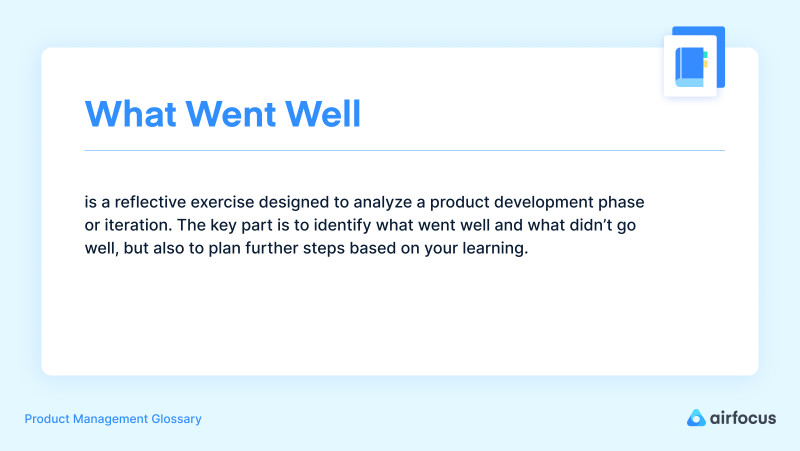
General FAQ
Glossary categories.

Feedback Management

Prioritization

Product Management

Product Strategy

Roadmapping
All product feedback in one place
Book a demo

Experience the new way of doing product management


The What Went Well Retrospective Template

What is the What Went Well retrospective template?
What worked well? What didn't go so well? How could we improve in our next Sprint? These are three existential questions that thousands of Agile teams raise at the end of each Sprint - or work cycle.
Before going any further, let's define what a retrospective should be.
“ A retrospective is a chance for a team to reflect and learn from the past within a structured meeting. The main aim is to inspect the situation and adapt to the reality. ”
- Aino Vonge Corry, Retrospectives Antipatterns
Simply put, the purpose of retrospectives is to help teams improve continuously.
Traditionally, a retrospective would allow a team to reflect collectively on three key questions: "What went well?" , "What didn't go so well?" , "How could we improve?" .
Good news, this is exactly what the What Went Well retrospective template delivers. 👌
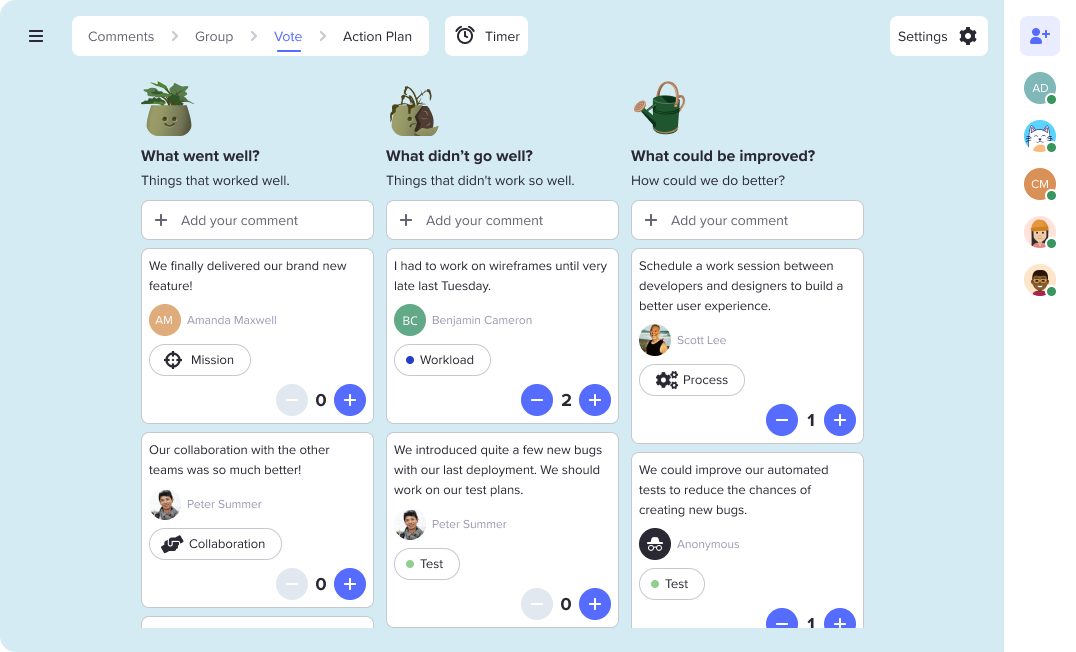
How does the What Went Well retrospective format work?
What Went Well is a simple but straight-to-the-point retrospective format. This activity works for all your Sprint retrospectives , project post-mortems , or team retrospectives . It is also a valuable tool for personal introspection.
Given the simplicity of this format, you can directly begin your meeting by presenting each of the 3 retrospective questions below.

Ask each team member to suggest one idea per note (or comment). In this category, you will discuss any practice, process, or behavior that helped the team move toward success during the Sprint.
You can also take the time to highlight actions or the attitude of certain members who contributed to the team's success.
For example:
Our testing processes really allowed us to identify and correct bugs before deployment.
Our weekly meetings with Team Marketing helped to align our respective needs.
Andy, thanks for offering group coding sessions on Friday afternoons!

This section records all the things that didn't work as expected. The goal is to speak transparently about the processes, practices, or behaviors we would like to correct.
To maintain a high level of psychological safety , remind the participants that it is not about settling scores or pointing the finger at people. It is all about stating facts. Use the Prime Directive to make the exercise more effective.
For example :
We did not properly anticipate the workload to support the Marketing team.
I was slowed down by a lack of information in my Jira tasks.
Some requests to modify the scope of work arrived too late, at the end of the Sprint.

Here we are! This column is your sandbox to develop new ideas or areas for improvement. The golden rule is to find action items that the team can complete.
Here are other examples to better understand this section:
Better estimate tasks to help the Marketing team for the next Sprint.
Review task descriptions and requirements before assigning them.
Involve stakeholders earlier in our ideation process.
Once this retrospective format has been mastered, you will be able to explore our Agile retrospective ideas and try new activities!.
Why is the What Went Well retrospective template so effective?
We highly recommend What Went Well for newly formed teams, as well as teams who want to discover the potential of retrospectives and host one for the first time.
The simplicity of this activity also makes it the perfect model for a first online retrospective. Remember that using and mastering a new tool can sometimes take time (e.g., the tool may be lacking in its intuitive aspect, or some people may be reluctant to the proposed change). This is why choosing a very simple activity like What Went Well can maximize your chances of offering your team a caring and productive retrospective.
Before you dive into your next retrospective, here's a piece of advice: take the time to go through each comment posted by your team members. Let the discussions flow and then collectively determine action items - on which the team commits to start improving quickly.
Indeed, even though What Went Well looks super simple, you need to give people time to express themselves.
Icebreaker question examples for the Glad Sad Mad retrospective template
We always recommend starting a retrospective with a check-in session and/or an icebreaker activity.
When beginning your retrospective, spend a few minutes breaking the ice with your team members - you will benefit from their full attention, and your retrospective will only be better!
With Neatro, we invented the Question Game: an icebreaker of more than 400 questions grouped under 4 themes.
Questions on the theme “Getting to know yourself”:
What is your favorite card game?
Is there any podcast you'd like to recommend?
What is your idea of a perfect vacation?
What sport would you compete in if you were in the Olympics?
What is the most unusual place you have visited?
Questions for “Having fun together”:
Tonight, we're all going for karaoke. Which song will you sing?
Hey, Chef! What is the best dish you can cook?
How would you say your name if you were an alien?
What fictional place would you like to visit? Tell us why.
Share your favorite 'dad joke' or pun.
Questions for “Improving team spirit”:
What are the best ingredients of a successful retrospective?
Describe your ideal work day in one sentence.
What's your best tip to stay zen all day long?
What is one thing you value about your team?
What's the most memorable gift you've ever received at work?
Finally, the theme of “Questions for reflection”:
If you could travel back in time, where/when would you go and why?
If you had the power to teleport yourself, where would you go right now?
Who is someone you admire in your life and why?
What major issue do you believe technology will solve soon?
If you could remain a certain age indefinitely, which age would you choose?
Want more? Check out our guide to the top 100 icebreaker questions or the " 2 Truths and 1 Lie " icebreaker activity.
One last thing! Claim your 30-day free trial to use the What Went Well retrospective template and break the ice with the Question Game in Neatro .
Enjoy your retrospective!

Home PowerPoint Templates Models What Went Well PowerPoint Template
What Went Well PowerPoint Template
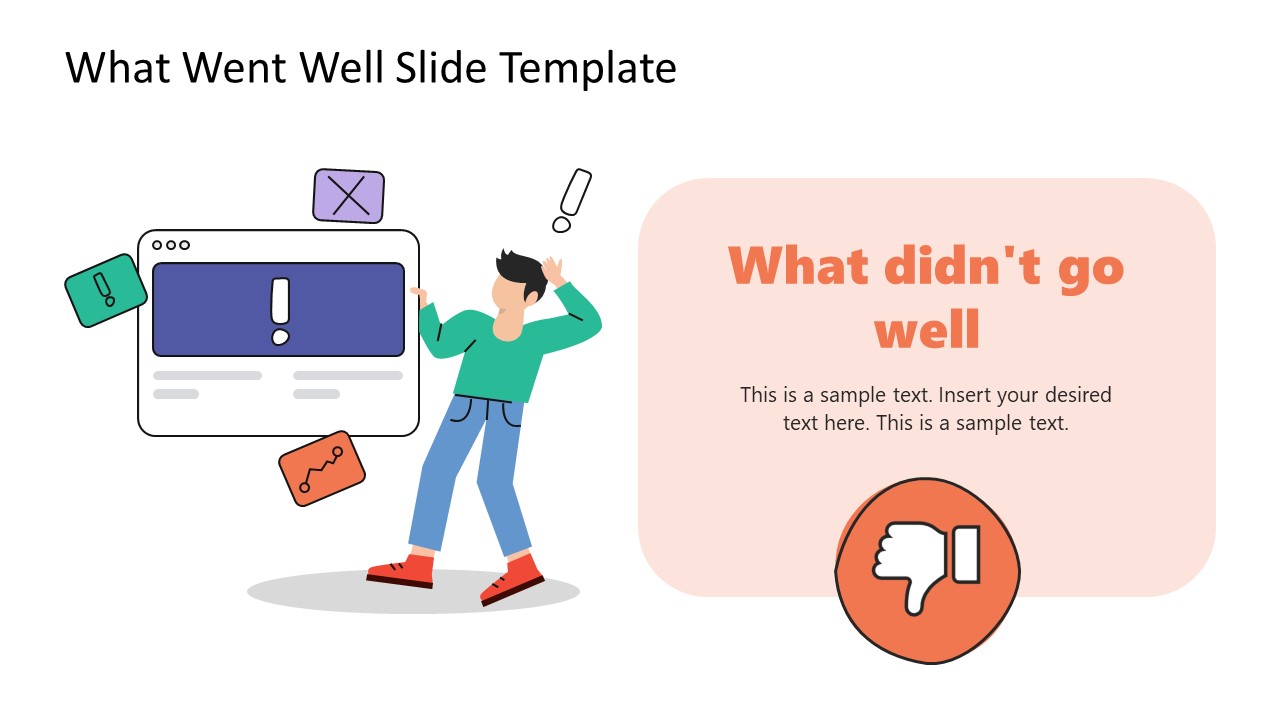
Discuss the pros and cons of your project and outline the necessary improvements using our featured What Went Well PowerPoint Template . This PPT template is crafted using PowerPoint shapes and illustrations. Users can conveniently add their data to the required segments and prepare enthralling presentations about their sessions, projects, business ideas, meetings, etc. Our agenda in designing this customizable template is to display the positive & negative aspects of an event and to discuss what can be improved next time. For instance, an event organizer can list the gains, losses, and required improvements of the last event he conducted. Likewise, project managers and business teams can especially grab this template for their professional presentations .
This What Went Well PowerPoint Template carries four slides. The first shows a human illustration of a person standing in a confused state with a screen. The screen also displays the signs of loss and exclamation. The second slide is the opposite and shows a satisfied person sitting on his computer. So, users can explain the gains & losses using these two slides.
Similarly, the third slide has a scene where a person holds a megaphone; this slide is to mention the necessary improvements. The last slide is a summary page, to mention all three points on a single page for consideration by the audience or team. Bright colors are used in the shapes. Presenters can modify these colors and change other features according to their preferences.
In addition to business and project management, this PowerPoint template is also usable for educational, scientific, and research purposes. Presenters can grab this layout and edit it using Google Slides and Keynote. Download and try it now!
You must be logged in to download this file.
Favorite Add to Collection
Details (4 slides)

Supported Versions:
Subscribe today and get immediate access to download our PowerPoint templates.
Related PowerPoint Templates

Global Logistics PowerPoint Template

Creative Agency Company Profile PowerPoint Template
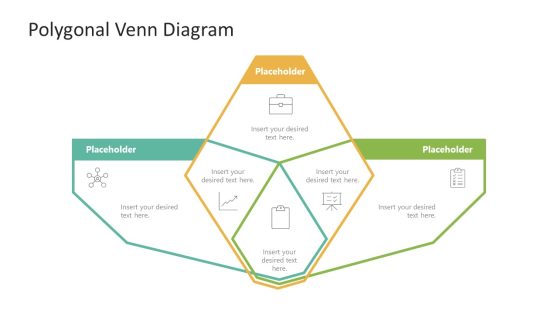
Polygonal Venn Diagram

Animated Student Intro PowerPoint Template
Advertisement
Supported by
Huey Lewis Lost His Hearing. That Didn’t Stop Him From Making a Musical.
“The Heart of Rock and Roll,” a Broadway show built around the songs of Huey Lewis and the News, has given the singer a reason to “get out of bed.”
- Share full article

By Dave Itzkoff
After Huey Lewis learned that a syndrome of the inner ear called Ménière’s disease had caused him significant hearing loss and left him unable to play or hear music, he faced the difficult task of having to tell his friends and peers.
Lewis, whose wry lyrics and rumbling vocals powered Reagan-era pop hits like “I Want a New Drug” and “If This Is It,” turned to people like Tico Torres, the longtime Bon Jovi drummer, whom he’d gotten to know on golfing trips. But their conversation proved to be an unexpected source of the pragmatic philosophy that Lewis built his career on.
Over a breakfast interview last month, Lewis delivered a lively, solo re-enactment of that fateful talk with Torres.
“He goes, ‘Hey, Huey, how ya doing?’” Lewis recalled. “I say, ‘Tico, it’s not good.’ And I begin to explain. I said, ‘I’ve lost my hearing and I can’t hear pitch. I can’t sing.’”
“I’m telling him the whole story and he’s going like this” — here, Lewis lowered his head, furrowed his bushy brows over his eyeglasses and shook his head in dismay. Slipping into an imitation of Torres’s New Jersey accent, Lewis said, “When I finish, he goes, ‘Whaddaya gonna do?’”
“So that’s my mantra,” Lewis continued. “What are you going to do? Really, it’s a pretty good question. I don’t know. Still working on it.”
Lewis had already halted his performing career before he went public with his diagnosis in 2020. But while his relationship to his art has fundamentally changed, he has continued to work on a new Broadway musical, “The Heart of Rock and Roll,” which is built around many of the songs he made famous with Huey Lewis and the News.
The musical, which opens on April 22 at the James Earl Jones Theater, spins Lewis’s tunes like “Hip to Be Square,” “Workin’ for a Livin’” and the title track into a fictional story set in the 1980s about a couple (played by Corey Cott and McKenzie Kurtz) torn between pop-star ambitions and corporate opportunities.
It is a project more than a decade in the making, one that began before Lewis learned about the disease that has upended his life and given the musical an unexpected sense of urgency.
As Lewis, 73, explained, “Zen Buddhists say you need three things: Something to love, something to hope for and something to do.”
“I got plenty to love,” he continued. “So this is my hope-for and my to-do. It keeps me from reflecting on my [expletive] hearing.”
A gregarious, exuberant storyteller, Lewis will readily regale a listener with tales from his picaresque career, like his formative days in Clover, a Bay Area band that arrived in London just in time to see their country-rock sound become swept away by the punk movement; or the hours he spent driving to set with Robert Altman when Lewis played a role in the filmmaker’s 1993 ensemble comedy-drama “Short Cuts.”
Recalling some of Altman’s advice, Lewis said, “He told me, ‘Learn the script. Read it every day. Find your character to the point where you know what he had for breakfast. And then don’t listen to anybody.’”
Lewis’s fellow musicians describe him as dedicated and reliable, which comes across in Bao Nguyen’s documentary “The Greatest Night in Pop,” about the making of the 1985 all-star charity song “We Are the World.”
In response to email questions, Lionel Richie recalled Lewis coming onto the project at the last minute, taking over a part that had been written for Prince.
Even so, Richie said, “I remember him eagerly jumping in with confidence and patience.”
“The Huey we saw in the documentary all those years ago is the same Huey we see today,” Richie added. “Fast forward to the night of the documentary premiere — he was still a nervous wreck over that night while watching the screening! His humor, his compassion and his welcoming spirit are just a few of the things that haven’t changed since the day I met him.”
In person, Lewis can hear well enough to conduct face-to-face conversations. He sometimes uses a discreet, disc-shaped listening device, which broadcasts wirelessly to a hearing aid in his ear.
But when he is in group settings, Lewis said, it can feel as though he is “in a cocoon.”
“I sit there like this,” he said, pretending to nod and smile at nothing in particular. “Can’t hear a thing.”
Lewis is also candid in talking about the despair he felt after learning that he might never be able to perform music again. Though he had experienced hearing loss in his right ear since the 1980s, he said the hearing in his left ear became suddenly and significantly distorted before a show in Dallas in January 2018.
“I’m mainly a half-full guy,” Lewis said, but what followed were “the most miserable six months of my life.”
“I contemplated my demise,” he said. “I laid in bed. I tried acupuncture, cranial massage, chiropractors, all-organic diet.” No matter which doctors he spoke to or which cures he tried, Lewis said they all yielded the same results: “Nothing.”
In that period, Lewis said that talking to his grown children — his son, Austin, and his daughter, Kelly — is what eventually gave him the confidence to move forward. “They said, ‘Come on, Dad. Get out of bed, Dad,’” he explained.
When Lewis felt able to resume work, “The Heart of Rock and Roll” — several years into its development — was ready for him to return to it.
The production’s origins trace back to 2009 when the producer Tyler Mitchell contacted Lewis about turning his music into a stage show.
Mitchell, who once bagged the musician’s groceries as an adolescent when they both lived in Ross, Calif., said several songs already had a narrative thread.
“His songs resonate with so many people because they tackle a lot of relatable subjects: following your dreams versus playing it safe, love and relationships, friendship, blue-collar working,” Mitchell explained. In his idealized version of the show, he said, Lewis’s songs would provide not just the score but “a massive part of the actual storytelling.”
But Lewis, who has done two stints as Billy Flynn in the Broadway revival of “Chicago,” had been approached with similar offers and was wary.
When it came to the genre of jukebox musicals — he and his creative partners prefer the term “catalog musicals” — a show was not guaranteed to be a hit just because it used popular songs.
As Lewis put it, “If the Beach Boys can’t succeed, and Abba does? I’m just saying. But what we forget about ‘Mamma Mia!’ is that the book really is great.”
Lewis wanted a show to tell a compelling story, and he felt he found that in a pitch from the screenwriter Jonathan A. Abrams (“Juror No. 2”).
Abrams said he began constructing the musical’s book by writing down lyrics to the group’s various songs, hanging them on his wall and studying them in obsessive detail.
“I stood back like I was looking at a painting,” he said. “And words would jump out. ‘Hip’ and ‘heart,’ and ‘soul’ and ‘power’ and ‘love.’ From there, I was able to start to formulate what this thing is demanding to be.”
Lewis did not particularly mind that the show does not tell an autobiographical story, explaining that many of his best-known songs were only ever loosely based on his life.
“You know, the muse comes when she comes,” he said. “It’s usually from something personal. And when you begin to write the song, you exaggerate. You embellish.”
Readings and workshops followed, but only a few weeks before announcing that the show would have its premiere at the Old Globe Theater in San Diego, Lewis experienced his abrupt hearing loss in Dallas.
The show’s collaborators learned about this from Lewis soon after.
“It was very, very painful to watch that happen to such a great person who loves music, and loves performing so much,” Mitchell said. “To have that part of his life taken from him was truly difficult.”
But Mitchell said he did not contemplate halting or canceling the plans for the musical. “Huey would never let that happen,” he said. “Huey doesn’t give up.”
At the Old Globe, Lewis was on hand to contribute — and to step back when he felt he wasn’t needed, said the musical’s director, Gordon Greenberg, who directed the 2016 Broadway production of “Holiday Inn.”
“He was there every day in rehearsals, 9 a.m. with us, laughing and offering suggestions,” Greenberg said, “and also understanding, where he said, ‘Here’s what I’m seeing — but I’m going to just let you guys go.’”
Lewis, who attended several performances of “The Heart of Rock and Roll” at the Old Globe, said with a chuckle, “I kept wanting to redirect — to change things. ‘Oh, no, he’s doing that all wrong.’”
He added, “I can’t get objective about it and that’s what I’ll do with this show forever. But I love it, and I like where we’re going.”
Reviewing the Old Globe production for The Los Angeles Times, Charles McNulty wrote that one’s enjoyment of the musical will most likely depend “on how nostalgic you are for Huey Lewis & the News,” adding that his own “surreptitious survey of theatergoers suggests this kind of material must have a pleasant tranquilizing effect.”
Lewis has contributed a new song for the Broadway production, called “Be Someone,” for which he shares credit with his bandmate Johnny Colla and the show’s musical director, Brian Usifer.
“I sang the parts into my iPhone and sent them to Johnny and Johnny demoed it all up and tweaked it,” Lewis explained in a phone interview, adding that this was a new process for him.
“I can sing to myself,” he said, “but I can’t sing to anything because I can’t hear pitch. We just changed the lyric two days ago. You got to pick your battles.”
Lewis is considering cochlear implant surgery and is scheduled to have a consultation this spring. He said that in his day-to-day life, he has gained a greater appreciation for pastimes like reading and fishing, but that nothing will ever quite replicate the pleasure of simply listening to a jazz album while he’s cooking at home.
“I don’t miss doing five shows a week,” he said. “I don’t miss travel at all. But I do miss a show once in a while. And I miss the circus that was our show. But OK — take away singing. Take away performing. I can’t even enjoy music.”
And yet, Lewis said “The Heart of Rock and Roll” has given him a new appreciation for his own music because the show presents it in new ways and makes narrative connections across his body of work.
“There’s a personality in the songs that I only recognized when I saw them performed in the show,” Lewis said. “I realized, wow, there’s a thread that runs through all these. It’s not my story but there’s a sensibility that pervades everything.”
Seeing his decades-old music reflected back at him, Lewis came to realize it was not just working but living and thriving in the production.
“To see the songs take on this other life,” he said, “it’s like seeing your children grow up and get a job.”
Dave Itzkoff is a former Times culture reporter. More about Dave Itzkoff
An official website of the United States Government
- Kreyòl ayisyen
- Search Toggle search Search Include Historical Content - Any - No Include Historical Content - Any - No Search
- Menu Toggle menu
- INFORMATION FOR…
- Individuals
- Business & Self Employed
- Charities and Nonprofits
- International Taxpayers
- Federal State and Local Governments
- Indian Tribal Governments
- Tax Exempt Bonds
- FILING FOR INDIVIDUALS
- How to File
- When to File
- Where to File
- Update Your Information
- Get Your Tax Record
- Apply for an Employer ID Number (EIN)
- Check Your Amended Return Status
- Get an Identity Protection PIN (IP PIN)
- File Your Taxes for Free
- Bank Account (Direct Pay)
- Payment Plan (Installment Agreement)
- Electronic Federal Tax Payment System (EFTPS)
- Your Online Account
- Tax Withholding Estimator
- Estimated Taxes
- Where's My Refund
- What to Expect
- Direct Deposit
- Reduced Refunds
- Amend Return
Credits & Deductions
- INFORMATION FOR...
- Businesses & Self-Employed
- Earned Income Credit (EITC)
- Child Tax Credit
- Clean Energy and Vehicle Credits
- Standard Deduction
- Retirement Plans
Forms & Instructions
- POPULAR FORMS & INSTRUCTIONS
- Form 1040 Instructions
- Form 4506-T
- POPULAR FOR TAX PROS
- Form 1040-X
- Circular 230
Need more time to file a federal tax return? It’s easy with IRS Free File
More in news.
- Topics in the News
- News Releases for Frequently Asked Questions
- Multimedia Center
- Tax Relief in Disaster Situations
- Inflation Reduction Act
- Taxpayer First Act
- Tax Scams/Consumer Alerts
- The Tax Gap
- Fact Sheets
- IRS Tax Tips
- e-News Subscriptions
- IRS Guidance
- Media Contacts
- IRS Statements and Announcements
IR-2024-106, April 11, 2024
WASHINGTON — With the April 15 tax filing deadline fast approaching, the Internal Revenue Service reminds taxpayers who need more time to file their return that receiving an extension is quick and easy through IRS Free File on IRS.gov. An extension gives taxpayers an automatic six more months – until Oct. 15 this year – to file their tax return.
The IRS also reminds taxpayers that payments are still due by the original deadline, even if they request an extension of time to file a tax return. Taxpayers should file even if they can't pay the full amount.
Use IRS Free File to get an extension online
One of the fastest and easiest ways to get an extension is through IRS Free File on IRS.gov. All individual tax filers, regardless of income, can electronically request Form 4868, Application for Automatic Extension of Time To File U.S. Individual Income Tax Return PDF , by using the IRS Free File partner software on IRS.gov.
To get an extension, taxpayers must estimate their tax liability on this form and file it by April 15, 2024.
By filing either a return on time or requesting an extension by the April 15 filing deadline, people avoid the late-filing penalty, which can be 10 times as costly as the penalty for not paying.
More time to file, not more time to pay
While an extension allows for extra time to gather, prepare and file paperwork, it's important to remember that an extension of time to file taxes is not an extension of time to pay. Taxpayers who owe should pay their entire obligation, or as much as they can, by the April 15 deadline to avoid penalties and interest.
Taxpayers who pay as much as they can by the due date reduce the overall amount subject to penalty and interest charges. The interest rate for an individual's unpaid taxes is currently 7%, compounded daily. The late-filing penalty is generally 5% per month and the late-payment penalty is normally 0.5% per month, both of which max out at 25%.
Make a payment and get an extension, automatically
Other fast, free and easy ways to get an extension include using IRS Direct Pay , the Electronic Federal Tax Payment System or by paying with a credit or debit card or digital wallet . There is no need to file a separate Form 4868 extension request when making an electronic payment and indicating it is for an extension. The IRS will automatically count it as an extension.
The IRS will work with taxpayers who cannot pay the full amount of tax they owe. Other options to pay, such as getting a loan or paying by credit card, may help resolve a tax debt. Most people can set up a payment plan on IRS.gov to pay off their balance over time.
Some taxpayers get automatic extensions
Special rules offer some taxpayers more time without having to request an extension:
- U.S. citizens and resident aliens who live and work outside of the United States and Puerto Rico get an automatic two-month extension, until June 15, to file their tax returns. However, tax payments are still due April 15 or interest will accrue on the unpaid tax.
- Members of the military on duty outside the United States and Puerto Rico also receive an automatic two-month extension to file. Those serving in combat zones have up to 180 days after they leave the combat zone to file returns and pay any taxes due. Details are available in Publication 3, Armed Forces' Tax Guide .
- When the U.S. president makes a disaster area declaration, the IRS can postpone certain tax deadlines for taxpayers in affected areas. Taxpayers in qualified disaster areas do not need to submit an extension electronically or on paper. Information on the most recent tax relief for disaster situations can be found on the Extension of time to file your tax return page.
Salman Rushdie speaks of stabbing that almost claimed his life: 'Taking power back'
"It became my way of controlling the narrative," he said of his book.
The attack lasted just 27 seconds, but writer Salman Rushdie said in that short amount of time he experienced the worst and best of humanity.
In an interview Monday with ABC News' "Good Morning America" co-host George Stephanopoulos, the 76-year-old author of "The Satanic Verses" recounted the 2022 attack on him at a lecture in Chautauqua, New York, allegedly by a 24-year-old man bent on carrying out a Fatwa imposed on Rushdie in 1989 by Ruhollah Khomeini, the former supreme leader of Iran.
Rushdie said he believed he was going to die, but then people who witnessed the attack rushed to protect him. He said a new book he has written chronicles the doctors who saved his life and how his wife, Eliza, became the heroine of his story for nursing him back to health.

"No question," he told Stephanopoulos. "I mean, lying there in this lake of blood, which was mine and was expanding, I remember thinking in a completely calm way, Oh yeah, I think I'm dying. And then, fortunately, I was wrong."
In his long road to recovery, Rushdie said he felt compelled to write a memoir about the horrific experience -- "Knife: Meditations After an Attempted Murder'' -- which will be available in bookstores on Tuesday. He said writing the book was his way of "taking the power back."
"It became my way of controlling the narrative if you'd like," Rushdie said. "What I felt is that the book itself, I mean, it's about a knife but it also kind of is a knife. I don't have any guns or knives, so this is the tool I use. And I thought I would use it to fight back."
On Aug. 12, 2022, Rushdie was speaking at the Chautauqua Institution about violence against writers when the alleged knife-wielding suspect, Hadi Matar, charged the stage and stabbed the writer more than a dozen times. Matar has pleaded not guilty to second-degree attempted murder and assault charges in connection with the attack.

It had been more than three decades since Rushdie faced death threats over his novel "The Satanic Verses," which was inspired by the life of the Islamic prophet Muhammad and was published in 1988. The book was deemed blasphemous by Khomeini and an insult to Islam. Khomeini issued a fatwa, or death sentence, against Rushdie.
Rushdie said Monday that he believed threats against his life had faded and all but forgotten. He conceded that he had let his guard down.
"I've been living here, George, close to 25 years in New York City and in that time, I've done hundreds of public events, you know, book tours, literary festivals, reading, lectures," Rushdie told Stephanopoulos. "And there's never been a hint of a problem until this time."
While his book is largely about the assassination attempt on him, he said it is also a love story.
"I always thought there were three people in this book. There's me, there's him, who I refuse to use his name," he said of the suspect. “And there’s my wife, Eliza. We had met five years before this attack took place."
Describing his marriage as the "happiest relationship of my life," Rushdie said his wife has been his rock, the guiding force behind his recovery.

"She was just astonishing in taking care of me and then looking after things and taking charge of things," said Rushdie, adding, "and bringing me back."
Related Stories

Top New York City comfort foods
- Apr 12, 12:58 PM

Sununu says Trump shouldn't drop out if convicted
- Apr 14, 2:32 PM

'This Week' Transcript 4-14-24: John Kirby
- Apr 14, 10:17 AM
In the "GMA" interview, Rushdie said he had a premonition of the attack that came to him in a "bad dream."
MORE: Salman Rushdie's condition improving as attack suspect charged with attempted murder
"You can explain the bad dream because the place I was giving the lecture was called an amphitheater. So I had a dream about being in an amphitheater, except in my dream it was like the Colosseum. It was like a Ridley Scott movie," Rushdie said. "And there was a gladiator with a spear stabbing downwards and I was rolling around on the ground. And I woke up from the dream quite alarmed and, at first, I thought, Oh, I don’t want to go. And then I thought it was a dream."
Rushdie, who bears scars from the attack on his face and is blinded in his right eye, recalled how time "became a very weird thing" during the stabbing and its immediate aftermath.
MORE: Salman Rushdie attack suspect: What investigators are saying
"It seemed to go very fast at moments ... and to me like an eternity at other times," Rushdie said. "I had a very weird experience of time in that extreme situation."
A longtime atheist, Rushdie said the near-death experience made him briefly believe in the supernatural.
"For a minute it did, and then it didn't, and maybe it should have," Rushdie said.
As far as his health goes, he told Stephanopoulos, "I'm alright. I think I'm, to my surprise and I think to everybody else's surprise, pretty well."
Matar, of New Jersey, was initially scheduled to go on trial in January, but his attorney was granted a delay to review the manuscript of Rushdie's book.
Rushdie said he plans to testify at the trial whenever it occurs.
"I believe the DA wants me to testify and so I will," Rushdie said. "That's OK. There's nothing I will say on the witness stand that I haven't already said in this book."

WH touts 'extraordinary success' against Iran
- Apr 14, 11:23 AM

Top Democrat slams Trump's abortion position
- Apr 14, 12:03 PM
ABC News Live
24/7 coverage of breaking news and live events
ESPN's Stephen A. Smith predicts 'with or without Giannis,' Bucks will lose to Pacers in NBA playoffs
The Milwaukee Bucks lost to the Indiana Pacers four times this season across five games.
If that were a best-of-seven playoff series, the Bucks would be eliminated.
Fortunately for the Bucks, the regular season is over. But maybe, unfortunately, they meet the Pacers in the first round of the 2024 NBA playoffs , more than three months since they last played.
And both teams look different. The Bucks have a new coach and the Pacers have All-Star forward Pascal Siakam, who was acquired in a trade. Then there's the uncertainty of whether Giannis Antetokounmpo will play as he recovers from a left soleus strain .
But will the results be any different of the Bucks, who are making their eighth straight appearance in the playoffs?
Playoff schedule: When do the Milwaukee Bucks play next in the playoffs vs the Indiana Pacers?
Stephen A. Smith says Giannis Antetokounmpo's injury status won't matter in this series, predicts Pacers will beat Bucks
The NBA Countdown crew on ESPN had some thoughts Sunday.
"With or without Giannis, Indiana’s winning this series," Stephen A. Smith said as confident as he always does in his takes. "They’re going to beat Milwaukee. That’s No. 1."
But Smith didn't stop there once he said the Bucks were going to lose.
"No. 2, when that happens, I think the Milwaukee Bucks should take a strong, hard look on using the asset that is Damian Lillard and moving him from Milwaukee to someplace else," Smith said. "I don’t think he wants to be there. I don’t think his play looks like he wants to be there."
Lillard told the Journal Sentinel in an interview for a profile in February that he's "happy" in Milwaukee.
"I am happy," Lillard said. "We win, man. Being a together team and also knowing how to find a way to win games and work through to get where we want to get to, to me that’s encouraging ‘cause of the experience that I’ve had. So I’m happy with that. We win a lot, man. It could be worse. We could be losing and things could be just a lot worse than it is. I’m happy with it."
The Bucks haven't done a lot of winning recently — they entered the playoffs losing eight of 11 games — but did enough to be the third seed and have home-court advantage in the first round. And it's the best team — at least as far as win-loss record — that Lillard has been on in five years. The Bucks finished 49-33.
Smith, of course, is known around these parts for throwing shade toward Milwaukee during the team's 2021 NBA championship season . However, when he arrived here, he warmed up to the city .
TV coverage: ESPN's Stephen A. Smith predicted Bucks head coach Adrian Griffin was going to be fired
Giannis Antetokounmpo's injury status will determine series, Adrian Wojnarowski predicts
His colleague, NBA insider Adrian Wojnarowski, also offered a bold prediction for the series, though it was tied to the health of Antetokounmpo .
"Without Giannis, we’re talking about Indiana advancing," Wojnarowski predicted. "That’s going to be the biggest factor, is his rehab. Not just play in this series against Indiana but be dominant."
Wojnarowski also highlighted Siakam as a difference-maker who has playoff and "championship experience." Siakam was on the Toronto Raptors team that beat the Bucks in the 2019 Eastern Conference finals on its way to the NBA title.
Chat: Ask Jim Owczarski your question about the Milwaukee Bucks
Pacers All-Star Tyrese Haliburton could be too much for Bucks in playoffs
And, as Wojnarowski added, the Pacers have Tyrese Haliburton , who has "absolutely destroyed this Milwaukee team." Haliburton has averaged 27 points against the Bucks in the five games, about seven above his season average of 20.1.
"Athletically, they haven’t been able to stay in front of these Pacers," Wojnarowski said.
Michael Wilbon noted that, besides athletic concerns, the Bucks have been carrying a lot of emotional baggage this season that he views is weighing on them.
"This isn’t the team we thought it would be," said Wilbon, a longtime NBA reporter and columnist, while mentioning the coaching change from Adrian Griffin to Doc Rivers.
Pressure is on Doc Rivers to get most out of Bucks vs. Pacers, Kendrick Perkins says
Not everyone was so down on the Bucks.
Kendrick Perkins, another ESPN panelist, said the Bucks have enough talent to defeat the Pacers even if Antetokounmpo can't play.
But he added it's on Rivers to get the most out of the team.
"Doc Rivers, he got to get into his bag. He has to coach," said Perkins, who was coached by Rivers on the 2008 NBA championship Celtics team.
"If I'm the Milwaukee Bucks and it’s no way in hell you should put any pressure on bringing back Giannis Antetokounmpo," Perkins said. "You have enough pieces. You have Damian Lillard, you have money-making (Khris) Middleton, you have Brook Lopez, who have shown us time and time again. And Bobby Portis is a 20 (point) and 10 (rebound) guy when he’s a starter.
"Doc Rivers has to coach his ass off."
George Stephanopoulos looks so dapper in loved-up photo with wife — but their date night didn't go to plan
The good morning america star is married to ali wentworth.

George Stephanopoulos enjoyed a night out with his wife Ali Wentworth over the weekend, and they both looked fabulous!
The celebrity couple pulled out all the stops for a special evening together, with George dressed in a smart tuxedo, while Ali looked stylish in an off-the-shoulder black gown.
However, the night didn't go completely to plan, as Ali revealed in the caption that they were having so much fun, that she ended up losing an earring on the dance floor!
"Moments before we were dancing to ABBA and I lost an earring…." she wrote.
Fans were quick to comment, with one writing: "So sad about the earring, but sounds like it was worth it!" while another wrote: "Great picture, I hope your earring turns up!" A third added: "Although sad, that's a good reason to lose an earring!"
You may also like
George and Ali are making the most of their time together now that they are empty nesters. The couple are doting parents to two grown-up children, Elliott, 21, and Harper, 18, who was the last to fly the nest in August.

Elliott had been studying nearby at Brown University, but has since moved across the pond for a semester in London.
The couple recently went to visit their firstborn, which coincided with George's job at GMA. The long-running anchor had been in the UK to report on Princess Kate's cancer battle, and during his time there, Elliott even did some work experience, helping her dad backstage on GMA.

George told his co-anchors Robin Roberts, Michael Strahan and Rebecca Jarvis during a live report from London: "Hey guys before you go, I have a special PA [production assistant] here in London today."
Elliott then briefly popped into the screen and gave a wave before quickly jumping out of frame, prompting George to say: "Oh no she got shy very fast!"
She then jumped back in for another brief "hi" to the delight of her dad's co-hosts, as he joked: "I decided to put her to work today," while smiling ear-to-ear, and Robin quipped: "It's great to see even a glimpse of her… enjoy your time there."
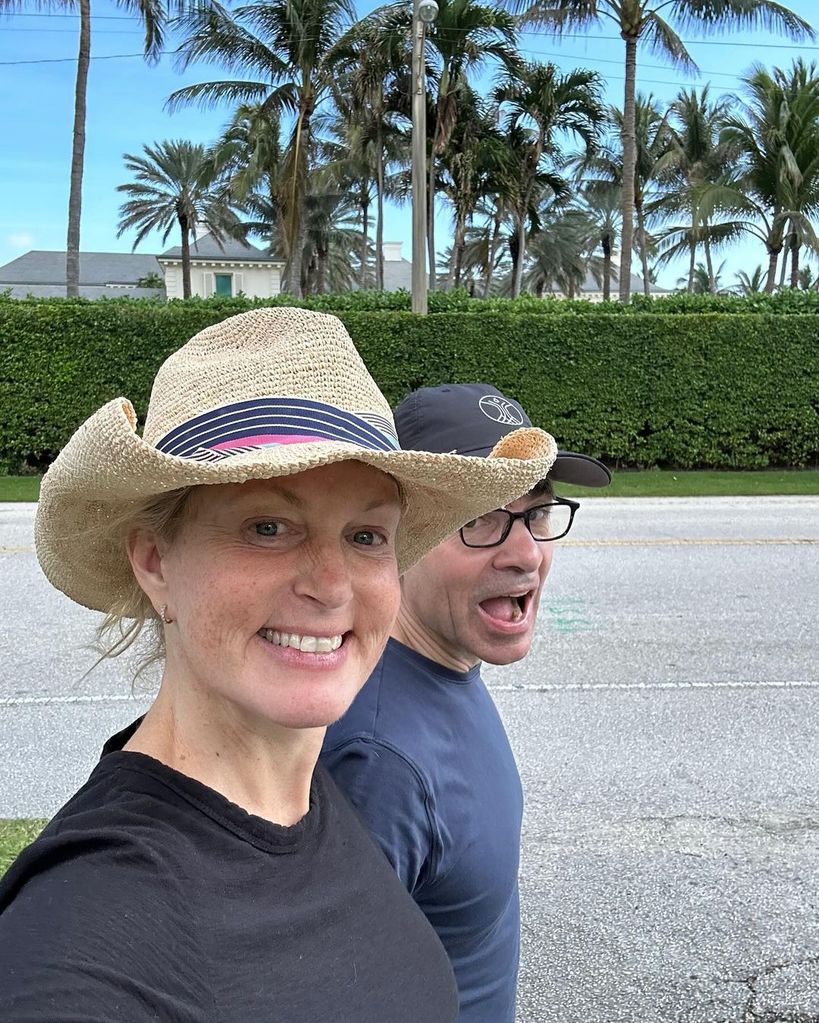
Ali has previously given an insight into their home life in New York City, back when both daughters were still living at home.
Chatting to Harry Connick Jr, she said: "I have two girls. George is the only guy in the house. For some reason, he gets beat up constantly. He is always wrong. He is an idiot. He is a loser, but in a loving way."
It's been a big struggle for the couple to adjust to becoming empty nesters, and Ali previously opened up about how sad she felt when her youngest left home.

At the time, Ali took to Instagram to post a number of photos of herself and George walking away from Harper's dorm on the college campus, hand in hand.
The couple have an incredible love story, and the actress spoke about how they first met at a book signing in Sarasota back in 2012. "I didn't care about politics, and figured he'd be the last person I'd be interested in," Ali said. "I was holding out for Hugh Grant or Matthew Perry."

After agreeing to go on the blind date to please her friend, Ali realized that she had a lot in common with George, even ordering the same meal – a crab salad – and proceeded to talk for hours.
George, meanwhile, told the New York Times: "You know how when you go on a date and the first 15 minutes are on automatic pilot? About 15 minutes in, she just leaned in and said something, and we were suddenly in another place, in another universe, immediately. We went from strangers to friends to being in love in days." The pair were engaged after dating for just two months, and got married at a ceremony performed by George's father, who is a reverend.
Read more HELLO! US stories here
Get the lowdown on the biggest, hottest celebrity news, features and profiles coming out of the U.S. Sign up to our HELLO! Hollywood newsletter and get them delivered straight to your inbox.
- George Stephanopoulos
- Ali Wentworth
- Celebrity Couples
More Celebrity News
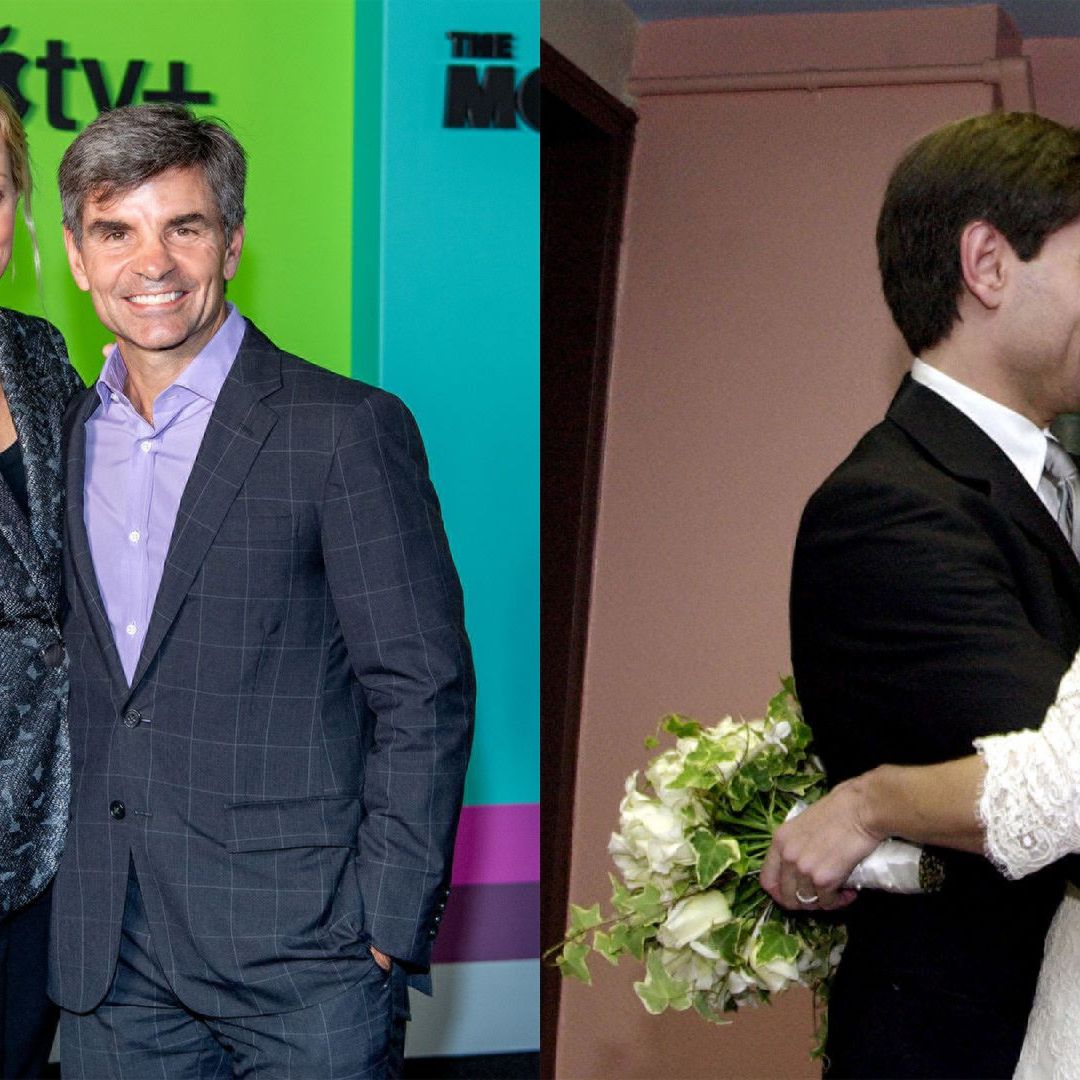
George Stephanopoulos and Ali Wentworth's unique relationship story - full timeline

George Stephanopoulos' wife Ali Wentworth reveals nerves as she begins new chapter

George Stephanopoulos' 'shy' daughter Elliott makes surprise on-air appearance on GMA live from London

George Stephanopoulos has jet black hair in must-see throwback photo with rarely-seen daughters

Nicole Kidman shares rare insight into raising teen daughters with Keith Urban: 'So lucky'

Sofia Vergara professes love for new boyfriend as he supports her while recovering from major surgery

Ryan Gosling gives sweet public shout-out to Eva Mendes and daughters during star-studded SNL appearance

Gallery Cutest couples at the Breakthrough Prize ceremony: From Katy Perry and Orlando Bloom to Alicia Keys and Swizz Beatz
George stephanopoulos pictured shirtless with pregnant wife ali wentworth in throwback beach photo, george stephanopoulos’ wife ali wentworth shares cryptic message after 'painful' time, gma's george stephanopoulos' wife sparks reaction from his co-stars as she embraces nature in new photo, gma's george stephanopoulos and ali wentworth melt hearts with beachside photo as they prepare for life-changing moment.

IMAGES
VIDEO
COMMENTS
5. The final tip is to learn from your experience and keep improving your presentation skills. After your presentation, reflect on what went well and what could be better. Celebrate your ...
This story can go on forever, alternating between events which seem good, and those that seem bad. In this spirit, you don't know whether this disastrous presentation is good or bad. In fact… 7. Devastating failure often sets the stage for later success. I've been reading Tim Ferris's latest book . The book is a compilation of people ...
Bad Presentations Happen To Good People. Realize that bad presentations do happen to good speakers and amazing people. Sometimes you can do all your homework, be clear on your message, practice, know your material backward and forwards and the presentation just misses the mark. Once I was invited to give a presentation on cultural trends.
Mistake 5: Being Too Verbose. Short, concise presentations are often more powerful than verbose ones. Try to limit yourself to a few main points. If you take too long getting to your point, you risk losing your audience's attention. The average adult has a 15- to 20-minute attention span.
It's likely about a fear of public humiliation rather than of public speaking. Shift the spotlight from yourself to what you have to say. Reject the voice in your head trying to destroy your ...
Even if you've prepared, practiced, and thought of every possible scenario, things can still go wrong during a presentation. Maybe your mic didn't work, or your slides wouldn't advance, or maybe ...
To give a great presentation, you might even incorporate relevant props or presentation slides. 4. Storytelling. According to Forbes, audiences typically pay attention for about 10 minutes before tuning out. But you can lengthen their attention span by offering a presentation that interests them for longer.
9. Irrelevance. 10. No clear call-to-action. Let's review each of these reasons in more detail: 1. You don't prepare enough. If you haven't put in the time to research and rehearse your presentation, it will show. You'll deliver a bad presentation.
Here are a few tips for business professionals who want to move from being good speakers to great ones: be concise (the fewer words, the better); never use bullet points (photos and images paired ...
So you presentation didn't go so well. There is some good news...you can absolutely learn from your mistakes. What do you need to do to improve your presenta...
Consider making the intimate presentation interactive, and make sure your message is broad enough to cater to the varying interests of the 500 people. Abrupt Endings or False Endings Some things are best left a mystery - Santa Claus, the Caramilk Secret - but not the end of your presentation.
Mishap #1 - You run out of time. Dragging a presentation on longer than your allotted time is one of the most common mistakes made by rookies in public speaking. It's critical to try to stay within your allotted time. In fact, if you can, end a littler earlier than you're supposed to!
I had to remember every compliant thing to say, go hand in hand with the script and be grilled at the end with questions. The presentation was a make or break, for the position. Boy oh boy, you bet I panicked and studied every last bit of info I can. I didn't have any trainers, all self taught and self-paced.
So of the parts of the presentation that I heard didn't go so well is the actually oral presentation. The preparation of the oral presentation had not been practiced so some of the presenters had to wing it on the spot. If I could do the presentation again, I would probably want to be there do I can actually see the presentation. ...
Because when a communicator has invested a lot of time and effort to lead a conversation or present a new idea and it doesn't go well, the emotion they feel is…well, at least it's over. It's behind me. And, I don't have to do that again for 90 days. Whew! It's an understandable feeling, but a short-sighted one.
My presentation didn't go so well.. I was so prepared and had everything i was gonna say sorted out, but as soon as i got up and stood infront of everyone Nothing, I couldn't say one useful sentence. I kept stopping in the middle of every sentence i was saying til the teachers stopped me and asked me some random questions because they knew i ...
In short, a 4 Question Retrospective gets the the team to reflect on the last, short period of time working together (often 2 weeks) and answer four specific questions: What went well?
Her speech didn't go well. She asks what she can do to regain her reputation. Menu. About; Services. Media Training. ... The night before the presentation, I found out that my uncle had gone into cardiac arrest and that he was dying. Needless to say, I was incredibly shaken and upset. I did not sleep much (maybe two hours), so when I got to the ...
Step 2: What didn't go well. Identify the challenges, setbacks, or failures encountered during the project or period. Provide specific examples and describe the impact of these issues. Explain why these things didn't go well and what could have been done differently to avoid or mitigate them. Step 3: What to improve
2. Reflect on the interview and think of ways to improve. Reflecting on your mistakes can be the key to knowing how to turn those signs an interview went bad into a learning opportunity for a future one. Even if you feel defeated now, no one can take away the experience from you.
What Went Well is a simple but straight-to-the-point retrospective format. This activity works for all your Sprint retrospectives, project post-mortems, or team retrospectives. It is also a valuable tool for personal introspection. Given the simplicity of this format, you can directly begin your meeting by presenting each of the 3 retrospective ...
Discuss the pros and cons of your project and outline the necessary improvements using our featured What Went Well PowerPoint Template.This PPT template is crafted using PowerPoint shapes and illustrations. Users can conveniently add their data to the required segments and prepare enthralling presentations about their sessions, projects, business ideas, meetings, etc.
April 10, 2024. After Huey Lewis learned that a syndrome of the inner ear called Ménière's disease had caused him significant hearing loss and left him unable to play or hear music, he faced ...
E&C Republican on "some good parts of the IRA". Buddy Carter, a key GOP leader on the E&C committee, said he likes parts of the Inflation Reduction Act. Why it matters: Carter is going to be deeply influential in Republicans' handling of the new climate law should his party keep the House after this year's elections.
IR-2024-106, April 11, 2024. WASHINGTON — With the April 15 tax filing deadline fast approaching, the Internal Revenue Service reminds taxpayers who need more time to file their return that receiving an extension is quick and easy through IRS Free File on IRS.gov. An extension gives taxpayers an automatic six more months - until Oct. 15 this year - to file their tax return.
The attack lasted just 27 seconds, but writer Salman Rushdie said in that short amount of time he experienced the worst and best of humanity.. In an interview Monday with ABC News' "Good Morning ...
PFOA 0 4.0 ppt PFOS 0 4.0 ppt PFNA 10 ppt 10 ppt PFHxS 10 ppt 10 ppt HFPO-DA (GenX chemicals) 10 ppt 10 ppt Mixture of two or more: PFNA, PFHxS, HFPO-DA, and ... If you get your water from a home drinking water well, then EPA recommends you conduct regular testing. If PFAS are found, you can take steps to lower the levels of PFAS. For more ...
Stephen A. Smith says Giannis Antetokounmpo's injury status won't matter in this series, predicts Pacers will beat Bucks. The NBA Countdown crew on ESPN had some thoughts Sunday. "With or without ...
George Stephanopoulos looks so dapper in loved-up photo with wife — but their date night didn't go to plan The Good Morning America star is married to Ali Wentworth 3 minutes ago 15 Apr 2024, 19 ...